Perugia: The Complete Guide

Nestled in the heart of Italy, Perugia is one of the country’s oldest centers, celebrated for its vibrant social life, rich university heritage, and much more. This modern city, steeped in history, stands atop a hill in the Tiber Valley and serves as the capital of Umbria. Known as a city of art and a lively cultural hub, Perugia’s medieval origins are evident in its fortified village structure, surrounded by a mighty city wall.
The city boasts top-tier museums, stunning natural landscapes, and a famous chocolate industry, celebrated annually at the delectable Eurochocolate festival. Whether you’re drawn by its historical charm, cultural vibrancy, or sweet treats, Perugia offers a unique blend of past and present around every corner.

History of Perugia
Ancient Origins: Perugia’s history dates back to ancient times, with evidence of settlements as far back as the Etruscan period. The city, originally known as Perusia, was one of the twelve cities of the Etruscan League and played a significant role in the region. Remnants of this era include sections of the ancient city walls and the well-preserved Etruscan Arch, also known as the Arch of Augustus, which stands as a testament to the city’s early importance.
Roman Era: In 310 BCE, Perugia was conquered by the Romans, who further developed the city. It became a significant Roman municipium, integrating Roman culture and infrastructure while maintaining its Etruscan roots. The city continued to thrive under Roman rule, becoming a hub for trade and politics in the region.
Medieval Period: During the Middle Ages, Perugia experienced substantial growth and prosperity. It became a free commune in the 12th century and developed into a prominent medieval city. The construction of the imposing city walls, numerous churches, and public buildings during this period highlights its medieval significance. Perugia was also known for its internal conflicts and power struggles among noble families, such as the Baglioni and Oddi, which shaped much of its medieval history.
Renaissance and Papal Rule: The Renaissance brought further cultural and architectural development to Perugia. The city became a center of art and learning, attracting artists like Pietro Vannucci, known as Perugino, who taught Raphael. However, this period also saw Perugia come under the control of the Papal States in the 16th century, following the Salt War (1540) against Pope Paul III, which ended in the city’s defeat and subjugation.
Modern Era: Perugia continued to evolve over the centuries, balancing its rich historical heritage with modern growth. The establishment of the University of Perugia in 1308 marked it as a center for education and scholarship, a status it still holds today. The city played a role in the Risorgimento, the movement for Italian unification, and was integrated into the Kingdom of Italy in the 19th century.
Cultural and Economic Development: In contemporary times, Perugia is renowned not only for its historical and cultural heritage but also for its vibrant social scene and economic activities. The city is famous for its chocolate production, celebrated annually at the Eurochocolate festival, and continues to be a major educational hub with its prestigious university attracting students from around the world.
Visiting Perugia for the first time and wondering what are the top places to see in the city? In this complete guide, I share the best things to do in Perugia on the first visit. To help you plan your trip, I have also included an interactive map and practical tips for visiting!
This website uses affiliate links which earn a small commission at no additional cost to you.
24 Best places to See in Perugia
This complete guide to Perugia not only tells you about the very best sights and tourist attractions for first-time visitors to the city but also provide insights into a few of our personal favorite things to do.
This is a practical guide to visiting the best places to see in Perugia and is filled with tips and info that should answer all your questions!
Palazzo del Capitano del Popolo, Perugia

We recommend to rent a car in Italy through Discover Cars , they compare prices and review multiple car rental agencies. Book your rental car here .
Piazza IV Novembre
Explore Perugia yourself with our self-guided walking tour!
Fontana Maggiore

Palazzo dei Priori (Town Hall)

National Gallery of Umbria

House Museum of Palazzo Sorbello

Nobile Collegio del Cambio

Nobile Collegio della Mercanzia

The Etruscan Well

Monument of Pietro Vannucci "Perugino"

Palazzo Baldeschi al Corso

Cattedrale di San Lorenzo, Perugia

Civic Museum at Palazzo della Penna

Underground Perugia
Piazza italia.

Rocca Paolina

National Archeological Museum of Perugia

Etruscan Arch

Acquedotto Medievale, Perugia

Museum Workshop Giuditta Brozzetti

Basilica di San Pietro, Perugia

Necropolis of Palazzone & Hypogeum of Volumni

Porta Sant'Angelo, Perugia

Castiglione del Lago

Best Time to Visit Perugia
Spring (April to June): Spring is one of the best times to visit Perugia. The weather is mild and pleasant, with temperatures ranging from 15°C to 25°C (59°F to 77°F). The city is adorned with blooming flowers, and the countryside is lush and green. This season is perfect for exploring Perugia’s outdoor attractions, such as its gardens, parks, and the surrounding Umbrian landscapes.
Fall (September to October): Fall is another ideal time to visit Perugia. The temperatures are comfortable, generally between 15°C and 25°C (59°F to 77°F), making it pleasant for walking around the city and enjoying outdoor activities. The fall foliage adds a beautiful touch to the scenery. Additionally, the city is less crowded than during the summer, providing a more relaxed atmosphere for sightseeing.
Summer (July to August): Summer in Perugia can be quite warm, with temperatures often reaching 30°C (86°F) or higher. While this is the peak tourist season, the city can become crowded, especially during the Umbria Jazz Festival in July. If you enjoy lively atmospheres and cultural events, summer is a great time to experience the city’s vibrant social scene. However, be prepared for higher accommodation prices and larger crowds.
Winter (November to March): Winter is the least popular time to visit Perugia, but it has its own charm. The weather is cooler, with temperatures ranging from 5°C to 15°C (41°F to 59°F). While some outdoor attractions may be less accessible, this season offers a quieter and more intimate experience. The Christmas season is particularly charming, with festive decorations and local celebrations. Additionally, winter visitors can benefit from lower accommodation prices and fewer tourists.
Average Temperatures in Perugia
- January 12°C 53°F 8
- February 14°C 57°F 10
- March 16°C 61°F 9
- April 20°C 68°F 8
- May 26°C 78°F 10
- June 32°C 90°F 8
- July 36°C 97°F 6
- August 35°C 94°F 5
- September 28°C 83°F 11
- October 24°C 76°F 11
- November 17°C 62°F 15
- December 12°C 54°F 10
How to get to Perugia
By Air: For those flying, the closest airport is Sant’Egidio Airport, also known as Perugia San Francesco d’Assisi – Umbria International Airport, located just 12 kilometers from the city center. From the airport, you can easily reach Perugia by taxi or by using the shuttle bus service that operates between the airport and the city.
By Train: If you are traveling by train, you can connect from major cities like Florence and Rome. Direct trains run regularly from Roma Termini to Perugia. The journey takes about 2 to 2.5 hours. You can also take a high-speed train to Florence and transfer to a regional train to Perugia. I always recommend to book your train tickets in advance as prices tend to be lower!
Book your train tickets to Perugia .
By Bus: Several bus companies, including FlixBus and Sulga, offer direct services from Rome’s Tiburtina bus station to Perugia. The bus journey can be a bit longer compared to trains but can be more economical, providing a comfortable travel experience with scenic views along the way.
By Car: Alternatively, you can drive to Perugia as part of a more extensive Italian itinerary. Renting a car and exploring Italy by road offers an incredible experience, allowing you to witness more of Umbria’s stunning countryside and venture off the beaten path.
Local Transportation in Perugia: Perugia has a comprehensive local bus network operated by Umbria Mobilità, connecting the city center with surrounding areas. Additionally, the MiniMetro is a light rail system that links the lower part of the city with the historic center, providing a convenient way to navigate the city’s steep terrain. Taxis are readily available throughout Perugia, and car rental services can be found at the airport and in the city center for those looking to explore the surrounding region.
Similar Blogs

Self-guided Walking Tour of Perugia (Map & Route!)
Welcome to Perugia, a city that beautifully blends its ancient heritage with a vibrant, modern culture. Nestled atop a hill in the heart of Italy, Perugia is the capital of Umbria and offers an enchanting journey through time with its cobbled streets, historic architecture, and rich artistic legacy. This self-guided walking tour is designed to […]

Walking Tour of Milan (Map and Route)
Welcome to Milan, a city recognized as one of the world’s four fashion capitals and a global hub of design. With its rich history and cultural significance, Milan is a key tourist destination that seamlessly blends tradition and modernity. The origin of the name Milan is uncertain, but one theory suggests it comes from the […]

Walking Tour of Assisi: Map and Route!
Welcome to Assisi, a picturesque hilltop town nestled on the western slope of Mount Subasio, standing proudly at 1,300 feet above sea level. With its commanding views overlooking the rivers Topino and Chiasicio, Assisi boasts a rich history that spans millennia. Originally known as Assisium, this walled city with its narrow, twisting streets and alleys […]
Cocoa-infused bonbons, Jazz & a subterranean city
Perugia travel guide .
About equidistant between Florence and Rome , the hilltop city of Perugia is one of Italy’s most unfairly overlooked destinations. Wrapped in layers of history, this city of 170,000 people has Etruscan roots, a respected university that dates from the 14th century, and a vibrant contemporary life, with chic bars and restaurants in its historic centre.
It is also home to two of Italy’s most popular celebrations: the Umbria Jazz festival , each July, and October’s annual Eurochocolate festival. While these draw passionate international crowds, Perugia still sees far less tourism than its Tuscan counterparts — picture Siena or San Gimignano in peak season. This means that you can wander the gloriously authentic hilltop city with its intimate little neighbourhoods, medieval and gothic architecture and fine museum without the hordes.
The lay of the land...
As the capital of landlocked Umbria, Perugia lacks the international flair of places like Venice or Florence. Instead, this preserved hill-town is the essence of Italy. Step through its ancient city walls and you can forget the rest of the world. Starting life as an important Etruscan settlement , Perugia has added onion-like layers of buildings ever since. As you walk around the town, you’ll find yourself jumping centuries in moments.
Take, for example, the underground escalator system that allows you to rapidly ascend through the core of the town. This takes you away from the worst of the summer heat, but also for a stroll through the past, via the underground city. In 1540, when Perugia lost a salt war, Pope Paul Farnese III destroyed much of the medieval city, building a new fortress on top. But underneath, entire streets remained intact. And today, as you navigate the subterranean city , you’ll see these medieval pavements, and doorways into rooms with windows and fireplaces.
Wander above ground, through the cobbled alleyways of the historic centre, and you could easily have stepped back in time 400 years, strolling from piazza to piazza by gothic palazzo’s and towering churches.
The Palazzo dei Priori , a 13th-century gothic palace on Perugia’s central Corso Vannucci, is home to Umbria’s great art gallery , Galleria Nazionale dell'Umbria . The collection is chronologically displayed over 40 rooms, ranging from Byzantine paintings to Renaissance masterpieces, including masters such as Pinturicchio and Perugino.
Piazza IV Novembre is impossible to miss, as all roads lead in this direction. This square is home to both the Palazzo dei Priori and the city’s cathedral, and has been at the heart of Perugia since it served as a forum in Roman times. Today, everyone gathers here to catch the sun, listen to music, and marvel at the wonders of medieval architecture.
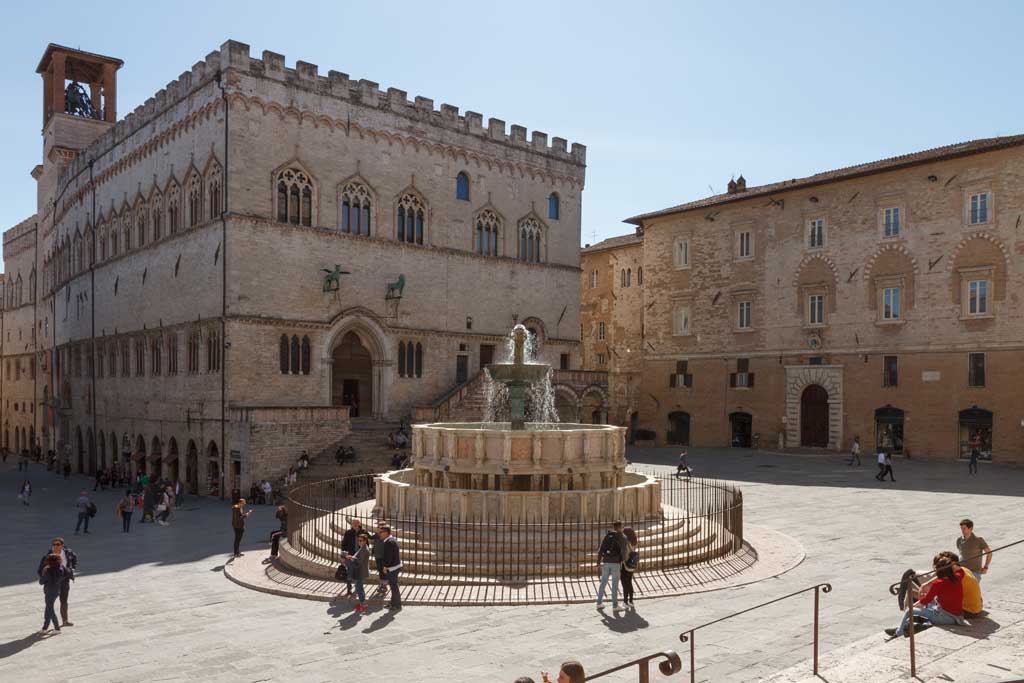
For insight into fine Italian craftsmanship, visit the stained glass studio of Moretti Caselli . Open daily by appointment, this studio showcases the same techniques that have been used for centuries, using light to bring life paintings on glass.
Eat & Drink this
Once you’ve had your fill of the sexy aperitivo spots radiating out of Piazza IV Novembre, head away from the lively centre along tiny cobbled streets descending into real neighbourhoods.
To the west of the Piazza you’ll find a typical Umbrian farm-to-table restaurant , Trattoria del Borgo. There’s nothing fancy here, but there’s the passionate reverence for the best of the region and the season that makes Italian food, in its glorious simplicity, the world’s best.
Out of Town
Get your chocolate fix with a tour of the Perugina factory , on the outskirts of the city, where these treats are still made today. At the Casa del Cioccolato, you will start with a tour of the museum, learning how a cocoa bean is transformed into the romantic hazelnut and chocolate Baci bonbons. You will also learn of the feminist history of this, I taly’s most famous chocolatier.

It would be a shame not to bring back some chocolates . Head to elegant Caffè Sandri , on Perugia’s high street, Corso Vannucci, which is one of the city’s prettiest pasticceria , and where you can purchase treats to take home.
Three Excursions from Perugia
- Assisi : St Francis’s hometown is popular with pilgrims, so you can find that you are not alone on your visit. Go anyway. It is moving to see the faithful as they flock to pay homage to Italy’s patron saint, a 12th-century son of this pretty hilltop town. The striped Basilica di San Francesco, built in his honour, is unmissable — literally: it rises from the town and can be seen for miles around.
- Norcia : Yes, this romantic town gets a special mention, in particular for the gastronomically inclined. This is the regional centre of fine food, and a culinary playground for anyone keen on truffles, ham and cheese. Wander this upland town and allow our concierge to organise a market tour and then a private cooking lesson at your villa.
- Cycling : The beautiful medieval hilltop towns of Umbria are easily reached by bicycle. Ask our concierge to arrange for bicycle hire and you can earn your lunchtime pasta while taking in classic rolling hills, olive groves and vineyards in the green heart of Italy. We particularly love visiting Spoleto, Orvieto , Bevagna and Norcia.
Book your luxury villa holiday
All experiences are exclusively available to you when you book a luxury villa in Italy with Tuscany Now & More. Too add on any enriching extras, contact our local Villa Specialists to share your villa shortlist and secure your stay.
(*)Please read this before completing any of our enquiry forms. The information you provide is to facilitate our response to your enquiry, a brochure request or to make a booking. Click here for our Web Privacy Statement for the full details of how your information may be stored and used.
By submitting your information, you agree that Tuscany Now & More may contact you via email or phone with commercial and informational purposes.
There is an option to discontinue direct communication and to do this simply click on this link [email protected] and follow instructions. All payments for bookings are done via a link having a Secure Sockets Layer (SSL) protocol. No information regarding credit card or debit card details is held by us.
Subscribe to our newsletter
Receive your Free ‟Tuscany in 10 Minutes Guide”
We respect your privacy. Learn how we handle your details in our Privacy Policy.
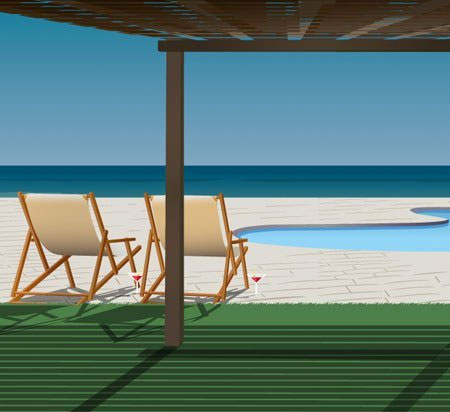
Keep in touch with Tuscany Now & More
Book your individual trip , stress-free with local travel experts
Select Month
- roughguides.com
- Travel guide
- Itineraries
- Travel Ideas
- Local Experts
- Related Articles
- Travel Advice
- Accommodation
Plan your tailor-made trip with a local expert
Book securely with money-back guarantee
Travel stress-free with local assistance and 24/7 support
Carlo DeSando
Wonderful Time in Italy We were covered from the moment we landed in Rome. The drivers were great, the connections were flawless, and it was well-planned a...
The provincial capital Perugia is the most obvious place to kick off a tour of Umbria. A bustling university town, known for its chocolate and its jazz festival, it offers at least a day’s worth of good sightseeing, and is not a bad place to base yourself if you want to explore the surrounding area: it has big-city amenities, and trains run to all the major highlights, complemented by fast new roads and an extensive bus network. The town hinges around a single street, the Corso Vannucci, named after the city’s most celebrated artist, Pietro Vannucci (c1450–1523), better known as Perugino. Lined with bustling pavement cafés, this is one of Italy’s greatest people-watching streets, packed from dawn through to the early hours with a parade of tourists, students and trendsetters.
Bloodlust in medieval Perugia
Galleria nazionale dell’umbria, travel ideas for italy, created by local experts.

8 days / from 2646 USD
Experience the hit TV show 'The White Lotus' in Sicily
Stay in beautiful Taormina with gorgeous views of Mount Etna and discover Sicily, including famous filming locations. Go on exclusive wine tastings, discover the Greek theater in Taormina with a private guide, visit other Sicilian towns and enjoy the crystal clear water on this week-long trip.

8 days / from 3289 USD
Enchanting Italian Lakes
Experience the picturesque lakes of Northern Italy, including Lake Garda, Como, Lugano and Maggiore; explore the charming Borromean Islands – former favourites of Ernest Hemingway – and stroll the romantic streets of Verona and Milan. All of this, and much more, with this self-drive trip!

16 days / from 3289 USD
From Venice to Florence: A Grand Tour of Northern Italy
From the atmospheric canals of Venice and the picturesque coastline of Cinque Terre, to the trendy designer boutiques of Milan and the Renaissance-infused streets of Florence, Northern Italy has plenty to offer. Experience it all with this comprehensive trip.
_listing_1475755133743.jpeg)
5 days / from 1615 USD
Florence: A Trip Back In Time
Florence. A mere mention of the name conjures up grand images of Renaissance romance, awe-inspiring art and astonishing architecture. Come and see for yourself.

4 days / from 1026 USD
Eternal Rome for the Weekend
Welcome to this whirlwind tour of Rome, also known as the Eternal City. Rome is one of the most photogenic cities on earth, so make sure you pack your camera.

6 days / from 2700 USD
Wine and food in Tuscany
Stay at a beautiful hotel in San Gimignano, a medieval hill town half way between Florence and Siena. Tuscany is known for its wines and food and that's what you'll be exploring on this itinerary - several wine and food pairings await. All hand-picked by your local travel specialist.
Medieval Perugia was evidently a hell of a place to be. “The most warlike of the people of Italy”, wrote the historian Sismondi, “who always preferred Mars to the Muse.” Male citizens played a game (and this was for pleasure) in which two teams, thickly padded in clothes stuffed with deer hair and wearing beaked helmets, stoned each other mercilessly until the majority of the other side were dead or wounded. Children were encouraged to join in for the first two hours to promote “application and aggression”.
In 1265 Perugia was also the birthplace of the Flagellants, who had half of Europe whipping itself into a frenzy before the movement was declared heretical. In addition to some hearty scourging they took to the streets on moonlit nights, groaning and wailing, dancing in white sheets, singing dirges and clattering human bones together, all as expiation for sin and the wrongs of the world. Then there were the infamous Baglioni, the medieval family who misruled the city for several generations, their spellbinding history – full of vendetta, incest and mass slaughter – the stuff of great medieval soap opera.
The Galleria Nazionale dell’Umbria is on the upper floor of the palace complex (lift or stairs), with the entrance through its opulently carved doorway. One of central Italy’s best and most charming galleries, it takes you on a romp through the history of Umbrian painting, with masterpieces by Perugino, Pinturicchio and many others, plus one or two stunning Tuscan masterpieces (Duccio, Fra’ Angelico, Piero della Francesca) thrown in for good measure. The entrance fee is worth every cent if you’re the slightest bit interested in early and mid-Renaissance art.
Top image: Perugia - a view of the old town and the Basilica di San Domenico, Umbria © Shchipkova Elena/Shutterstock
Discover more places in Italy

- Travel Guide Morocco
- Travel Guide Namibia
- Travel Guide South Africa
- Travel Guide China
- Travel Guide India
- Travel Guide Indonesia
- Travel Guide Japan
- Travel Guide Laos
- Travel Guide Malaysia
- Travel Guide Myanmar (Burma)
- Travel Guide Nepal
- Travel Guide Philippines
- Travel Guide Singapore
- Travel Guide South Korea
- Travel Guide Sri Lanka
- Travel Guide Taiwan
- Travel Guide Thailand
- Travel Guide Australia
- Travel Guide Fiji
- Travel Guide New Zealand
- Travel Guide Belize
- Costa Rica Travel Guide
- Travel Guide Cuba
- Travel Guide Guatemala
- Travel Guide Honduras
- Travel Guide Jamaica
- Travel Guide Nicaragua
- Travel Guide Panama
- Travel Guide Puerto Rico
- Travel Guide Trinidad and Tobago
- Travel Guide Albania
- Travel Guide Austria
- Travel Guide Belgium
- Travel Guide Bosnia-Herzegovina
- Travel Guide Bulgaria
- Travel Guide Cyprus
- Travel Guide Czechia (Czech Republic)
- Travel Guide Denmark
- Travel Guide England
- Travel Guide Estonia
- Travel Guide Finland
- Travel Guide France
- Travel Guide Germany
- Travel Guide Greece
- Travel Guide Hungary
- Iceland Travel Guide
The Rough Guides to Italy and related travel guides
In-depth, easy-to-use travel guides filled with expert advice.

Find even more inspiration here

Planning your own trip? Prepare for your trip
Use Rough Guides' trusted partners for great rates
written by Rough Guides Editors
updated 26.04.2021
Ready to travel and discover Italy?
Get support from our local experts for stress-free planning & worry-free travels.
- Where to stay
- Travel advice
Must-see attractions in Perugia
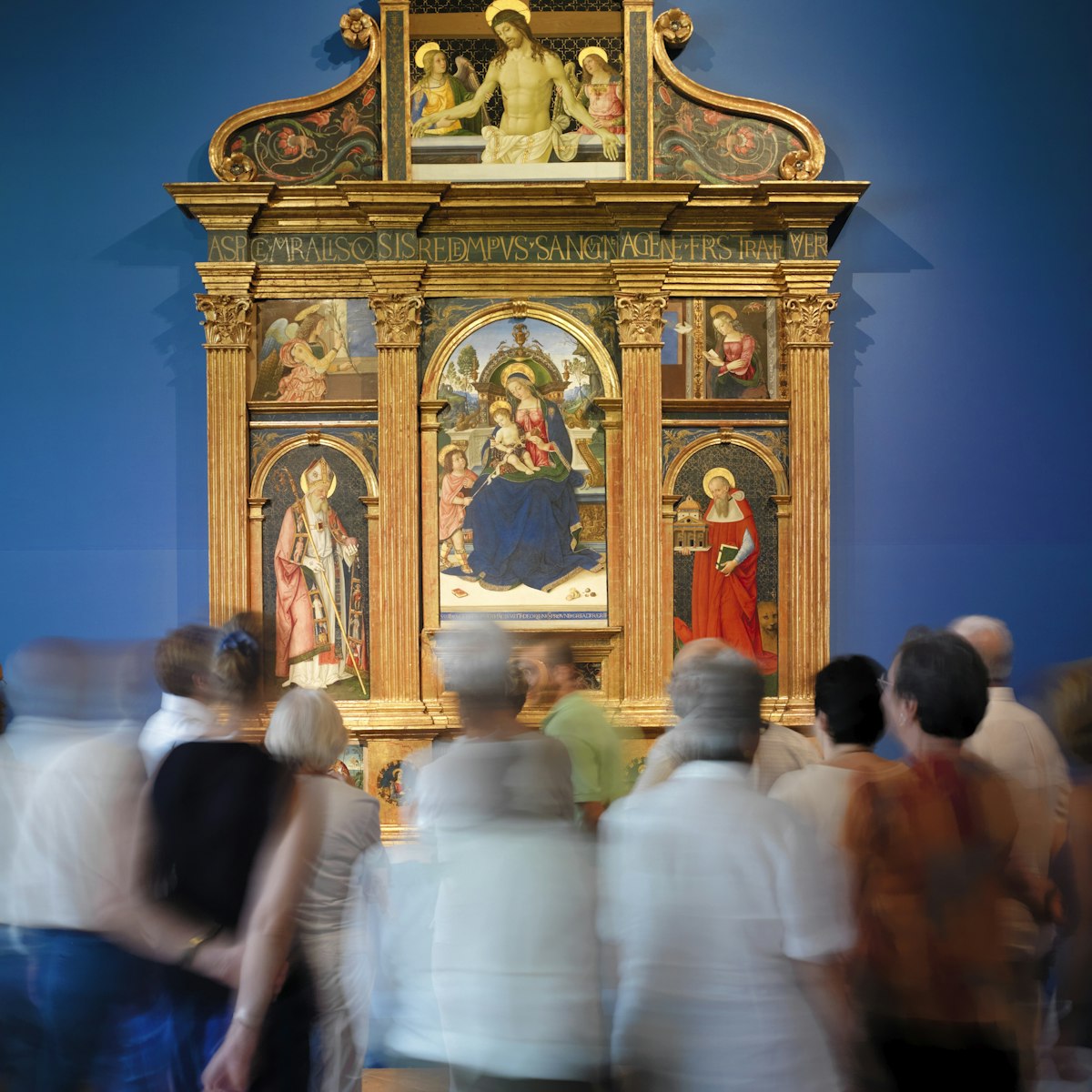
Galleria Nazionale dell'Umbria
Umbria's foremost art gallery is housed in Palazzo dei Priori on Perugia's main strip. Its collection, chronologically displayed over 40 rooms, is one of…

Palazzo dei Priori
Flanking Corso Vannucci, this Gothic palace, constructed between the 13th and 14th centuries, is architecturally striking with its tripartite windows,…
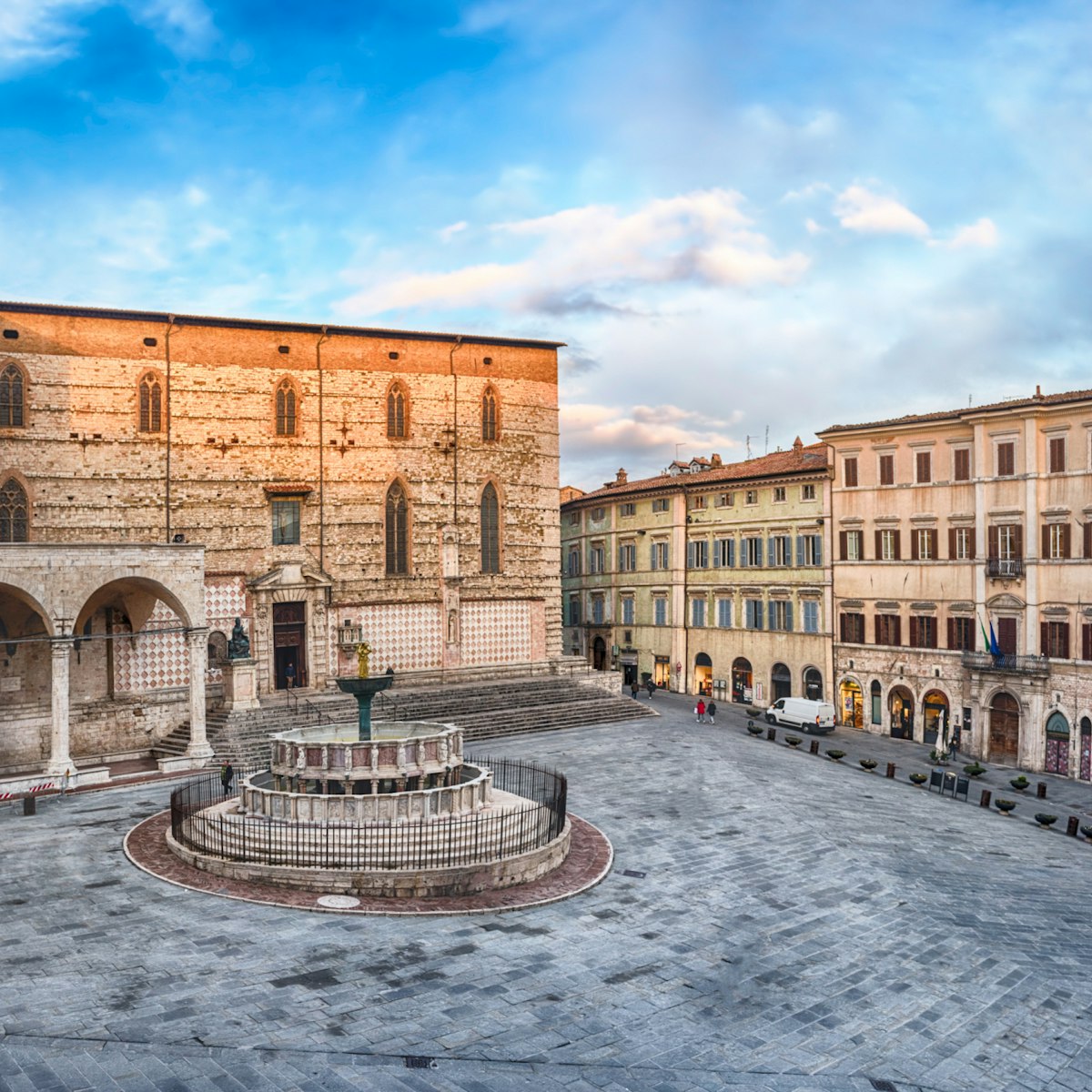
Piazza IV Novembre
In Perugia all roads seem to lead to Piazza IV Novembre. This historic square, flanked by Palazzo dei Priori and the Cattedrale, has been at the heart of…

Nobile Collegio del Cambio
Seat of Perugia's Moneychanger's Guild between 1452 and 1457, the extravagantly adorned Nobile Collegio del Cambio has three rooms: the Sala dei Legisti …
Chiesa di San Michele Arcangelo
Also known as the Chiesa or Tempio di Sant'Angelo, this 5th-century Romanesque church is one of the oldest in Italy (and the most appealing in Perugia)…
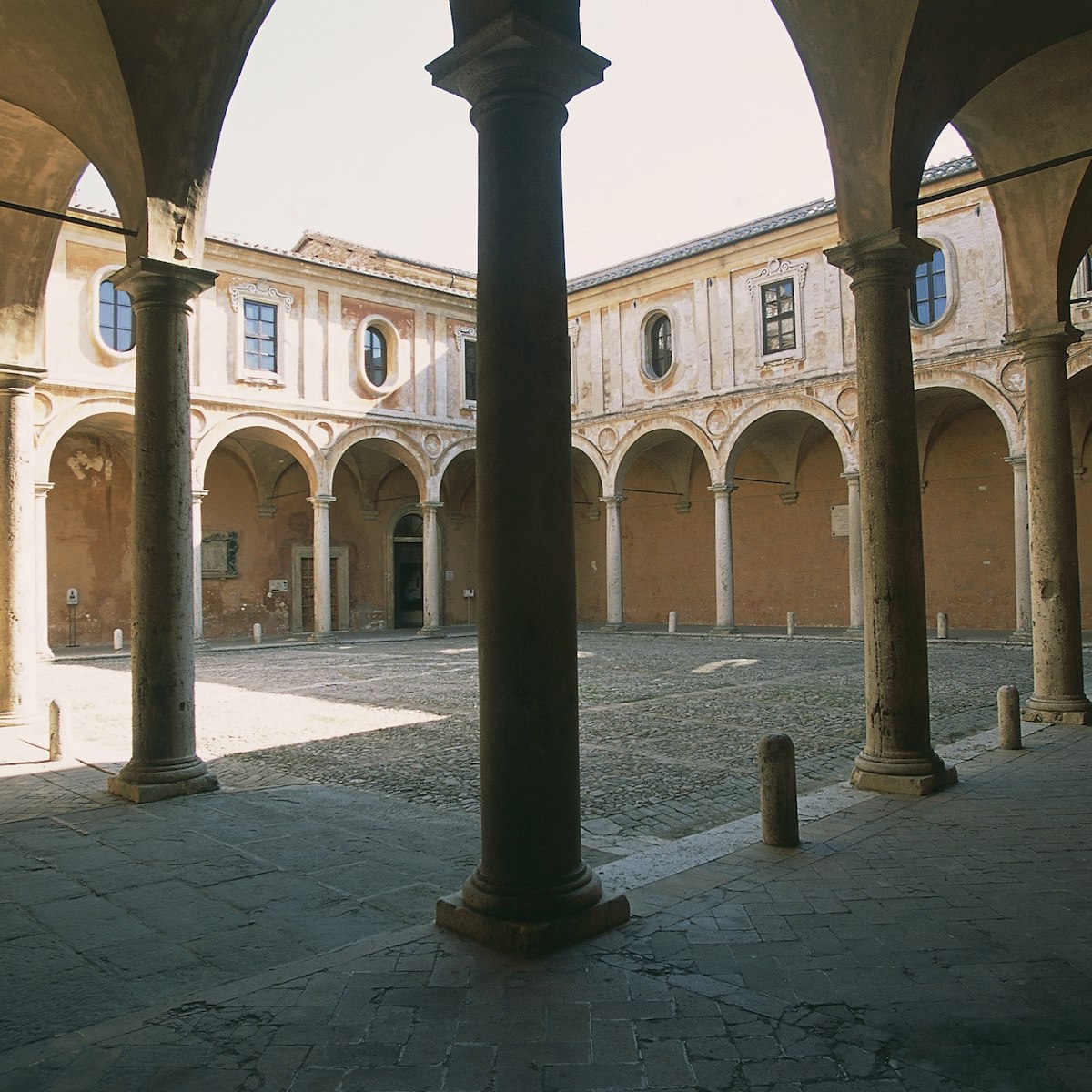
Cattedrale e Abbazia di San Pietro
South of the town centre, past the Porta di San Pietro, is this atmospheric 10th-century basilica complex. The basilica, overlooked by a landmark bell…
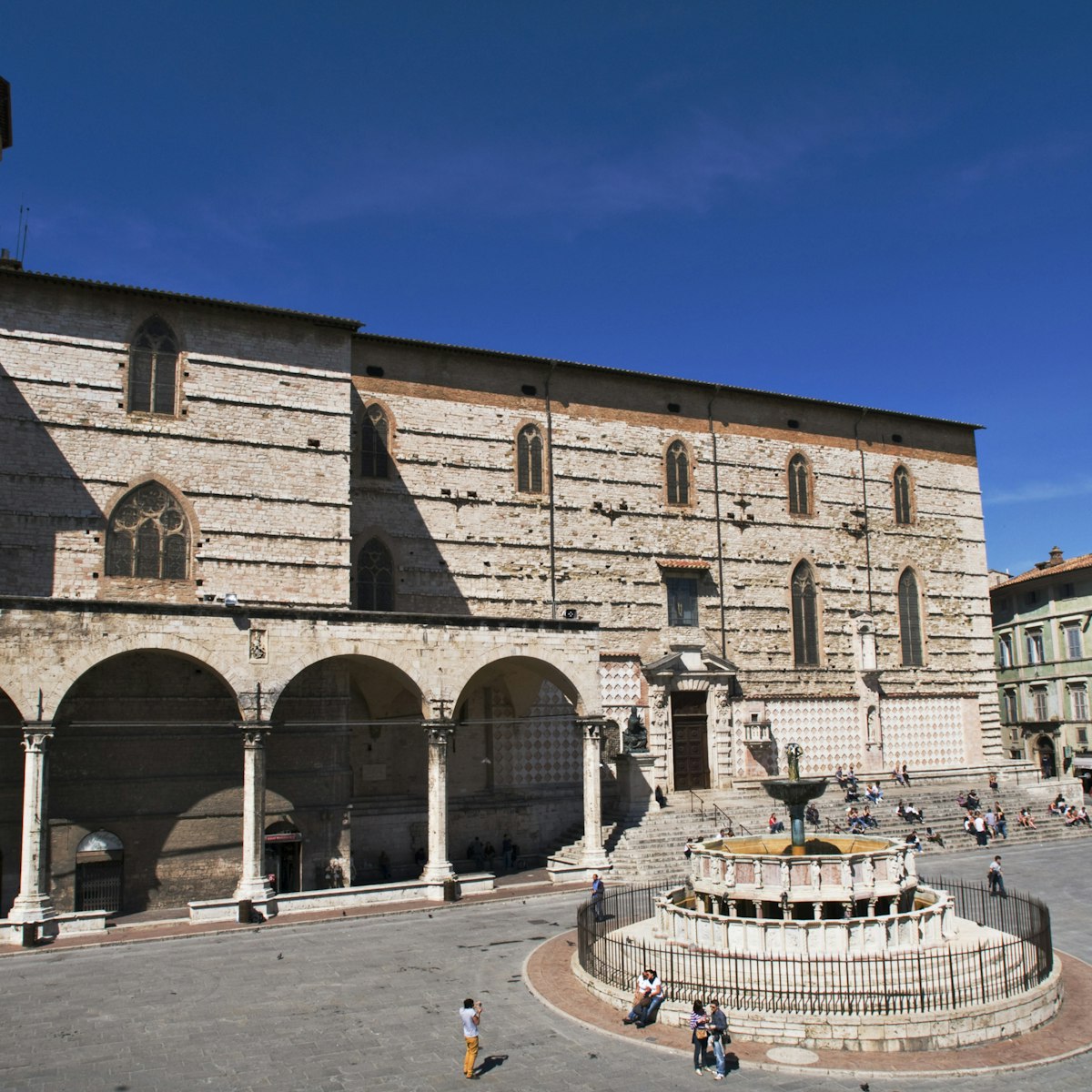
Cattedrale di San Lorenzo
Lording it over Piazza IV Novembre is Perugia's stark medieval cathedral. A church has stood here since the 900s, but the version you see today was begun…
Casa del Cioccolato Perugina
To visit the Wonka-esque world of Perugian chocolate, sign up for a 1¼-hour guided tour (in Italian or English, times vary) of the House of Chocolate…
Fontana Maggiore
The centrepiece of Piazza IV Novembre, the delicate pink-and-white marble Fontana Maggiore was designed by Fra Bevignate and built by father-and-son team…
Casa Museo di Palazzo Sorbello
This exquisite 17th-century mansion, once owned by the aristocratic Sorbello family, has been restored to its frescoed, gilt-clad, chandelier-lit, 18th…
Ipogeo dei Volumni
About 5km southeast of the city, the Ipogeo dei Volumni is part of the Palazzone necropolis, a vast 2nd-century-BC Etruscan burial site. The tomb, which…
Museo Archeologico Nazionale dell'Umbria
Housed in the former convent of the Basilica di San Domenico, Umbria's regional archaeology museum harbours an encyclopaedic collection of Etruscan and…
Rocca Paolina
Commissioned by Pope Paolo III in the 1540s, this fortress wiped out entire sections of a formerly wealthy neighbourhood. Its insides have long since been…
Palazzo Baldeschi al Corso
Originally dating from the 14th century, Palazzo Baldeschi features a series of palatial rooms decorated with stunning Murano chandeliers and frescoes…
Arco Etrusco
The most impressive of Perugia's ancient city gates, this landmark arch is one of Umbria's most important Etruscan monuments. It was originally built in…
Capella di San Severo
From the outside, this rather bland church northeast of Piazza IV Novembre looks nothing special. But step inside and you'll find a tiny chapel decorated…
Orto Medievale
Little known to visitors, Perugia's medieval gardens are entered from behind the Basilica di San Pietro. During the Middle Ages, monasteries often created…
Giardini Carducci
At the southern end of Corso Vannucci is this tiny park, with expansive views across the city's rooftops to the countryside and cypress-cloaked hills…
Sala dei Notari
The Sala dei Notari was built from 1293 to 1297 and is where the nobility met. The arches supporting the vaults are Romanesque, covered with vibrant…
Pozzo Etrusco
Just north of Piazza IV Novembre, you can venture down an Etruscan well. Dating from the 3rd century BC, the 37m-deep cylindrical shaft was the main water…
Nobile Collegio della Mercanzia
The Nobile Collegio della Mercanzia, HQ of Perugia's medieval merchants guild, features a 14th-century audience chamber with exquisite wood panelling.
Basilica di San Domenico
Erected in the early 14th century, Umbria's largest church is an imposing vision, with its distinctive bell tower and a 17th-century interior lit by…
Chiesa di Sant'Agostino
Behind its pink and white facade, this once magnificent Gothic church boasts a beautiful 16th-century choir by sculptor Baccio d'Agnolo. However, small…
More destinations you need to see
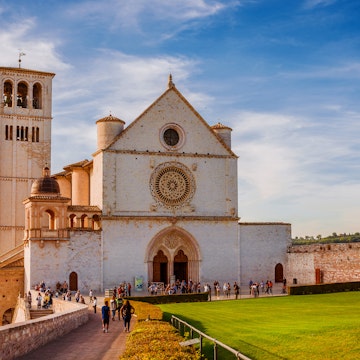

Home » Travel Guides » Italy » 15 Best Things to Do in Perugia (Italy)
15 Best Things to Do in Perugia (Italy)
Perugia has the honour of being both the capital of the Umbria region and of the Province of Umbria. Located in the centre of the country, Perugia is approximately equidistant from both Florence and Rome and sits in a hilltop region surrounded by valleys and mountains.
During the Etruscan era in Italy, Perugia was one of the main cities and prospered greatly due to its central location. During the Middle Ages, Perugia became and established University City and was known for its devotion to the development of arts and culture. Today the city still maintains this tradition and hosts many festivals and events such as the Umbria Jazz Festival.
When visiting Perugia, you can expect to find a myriad of gorgeous churches and historical structures, but also fantastic museums and attractions such as the Perugina Chocolate Factory. Furthermore, the surrounding countryside is bursting with stunning scenery and rich national parks to cater for those who love the outdoors. As a tourist destination, Perugia really does have a great deal to offer and its combination of historic and natural attractions will keep you entertained for days on end.
Lets explore the best things to do in in Perugia :
1. San Lorenzo Church

There are several notable examples of cathedrals that have remained unfinished throughout Italy and the Perugia Cathedral is one such structure.
Originally created in 1587, this cathedral is unique in the fact that its front façade does not face the main square it is constructed in.
The front façade is the wall that remains unfinished and this provides the church with a strange look.
Inside the church however is completely finished and is lavishly decorated.
Several marble columns hold up the ornate ceiling that is full of beautiful frescos.
Furthermore, one of the chapels contains the tomb of Pope Martin IV and several religious relics belonging to Pope Innocent III and Urban IV. Finally, the cathedral also houses a small museum that contains a selection of interesting religious artefacts and relics.
2. Piazza IV Novembre

The Piazza IV Novembre is the main square in the centre of Perugia and features a plethora of fantastic historical buildings and the beautiful Fontana Maggiore.
On this fine Piazza you can find the impressive Cathedral of Perugia, the Palazzo dei Priori, the Comune di Perugia and the Logge di Braccio.
In the centre of the square is the Fontana Maggiore that features a series of ornate statues and a central bronze bowl that spills over with water.
This charming square is a great place to admire some historic architecture or as a base to start a walking tour of Perugia.
3. Palazzo dei Priori

Designed in an ornate Gothic style, the Palazzo dei Priori is a huge building that sits across from the Cathedral in the Piazza IV Novembre.
This ancient structure has stood in the centre of the city since the 1300’s and has played an important role in Perugia’s politics.
At the front of this structure is a large circular stairway and a series of ornate arched windows; the top of the palace is lined with crenulations that make it look more like a castle.
Inside the palace, there is a huge amount of rich decoration including some colourful frescos depicting various biblical scenes.
4. Oratorio di San Bernardino

Located next to the Church of San Francesco, the Oratorio di San Bernardino is noted for its brilliant front façade and multi-coloured design.
You can find this grand structure in the eastern part of the old town approximately 10 minutes’ walk from the Piazza IV Novembre.
Due to its front façade that is created using coloured polychrome marble, it is considered to be the most significant examples of Renaissance art in Perugia.
The interior of this delightful oratorio is just as decorative and features several pieces of fine artwork and a plethora of gold trimming.
5. Church of San Pietro

This ancient church and monastery complex has survived since the 11th century and throughout the years it was an important place of power for the leaders of Perugia.
Located in the southern part of the town centre, the complex features a tall bell tower and a beautiful inner courtyard that contains a small fountain.
Inside the church, there is an important collection of art including a coloured fresco of Saint George and the Dragon, together with other artworks by various Renaissance artists.
The walls, arches and ceiling are covered with beautiful decoration and are simply stunning to admire.
6. Museo Archeologico

This delightful museum is located in the Piazza Giordano Bruno and is housed within an old convent of San Domenico.
Redesigned in 2009, the museum takes a chronological approach starting at pre-historic times and following on to the Roman period etc.
Within the separate collections you can find a wonderful display of artefacts collected from the Umbria province including Neolithic ceramics, Bronze Age carvings, weaponry and funerary items from Perugia and a series of Roman manuscripts.
Furthermore the is a reconstruction of an ancient Etruscan tomb that was found just outside the city.
This museum really does provide a fantastic look at the history of Umbria in a detailed manner.
7. Arco d’Augusto

Also known as the Etruscan Arch, this structure is one of the 7 remaining arches that served as an entrance to the city of Perugia in ages past.
Constructed in the 3rd century BC, this arch is one of the oldest pieces of architecture in the city and is considered to be the best remaining example of the cities original defences.
The front façade of the arch features a charming design and some of the original latin inscriptions can still be seen.
Over the years, various other aspects have been added to the arch and it now looks more like a fortress than a gateway.
8. Sciri Tower

This imposing tower can be found on Via Priori and is one of the tallest towers in the city.
Created in the 12th century, the tower stands at 46m high and belonged to the Sciri family.
As the only antique tower that remain in its original state, this structure is hugely important and is a fine example of architecture from this period.
Although simple in design, the tower is domineering and it is possible to climb to the top for fantastic panoramic views of Perugia.
9. Etruscan Well

Perugia is full of unique and interesting sites and the Etruscan well is one such attraction.
Located in the Piazza Danti, this well dates back to the 3rd or 4th century BC and is a marvel of architectural genius.
With a depth of 37m, and a diameter of 5m, this colossal well features an ornate bridge that spans the middle and crosses over the expanse below.
It is possible to get right down to the bottom of the well to get a true sense of its size proportion, and whilst walking through the town centre, a visit to this intriguing site is a must.
10. Perugina Chocolate Factory

Italy has some famous chocolate brands and Baci Perugina is known throughout the country for its spectacular chocolate kisses.
Located just outside the city centre, the Perugina Chocolate Factory provides a fantastic alternative attraction that is great for all the family, and especially for those who love the sweet stuff! A tour of the factory will take approximately 1 hour 15 minutes, during which you will see the production line in operation, sample some mouth-watering chocolate during a tasting session, and get to spend time in the historical museum.
There is of course a gift shop too where you can buy your own weight in chocolate if you desire!
11. Volumni Hypogeum

Another unique attraction just outside the historic city centre, the Volumni Hypogeum is an extraordinary place.
Discovered in 1840, this ancient tomb dates back to the third century BC and is part of a huge necropolis that contains over 200 separate tombs.
Dedicated to the Volumni family, this series of tombs contains many of the wealthy elite from Perugia from centuries past.
What makes this complex so special is its design and architecture – the building looks more like an ancient Roman structure with many palisades, pediments and ornate columns.
12. Parco Regionale del Lago Trasimeno

This immense body of water and regional park lies to the west of Perugia and can be reached by car in approximately 25 minutes.
With a surface area of 128km squared, it is one of the largest lakes in the region, and actually the fourth largest by surface area in Italy.
Surrounding the lake are a series of small coastal towns that are charming place to visit.
Furthermore, boat rides are available on the protected waters.
At the southern end of the lake is the interesting Isola Polvese – here you can find a beautiful stone castle and an interesting tourist information centre.
13. Parco Naturale di Monte Tezio

Located to the north of Perugia is the immense Monte Tezio and the natural park the surrounds it.
Standing at 961m high, the mountain is one of the tallest in the region and the slopes are covered with verdant green forests.
If you are looking for a place to hike and experience the beautiful outdoors of the Umbria region then this natural park is the perfect place.
The mountain side provides amazing views of the landscape and there is numerous different sites on the top such as a radio station and some old ruins of farm houses etc.
On clear days you are also rewarded with fantastic views of Perugia below.
14. Monte Vibiano Wine Tour.

Perugia is surrounded by some fantastic countryside and this region of Italy is known for its production of fine wines.
The Monte Vibiano winery is a wonderful place to visit and the brilliant eco-tour provides you with the chance to explore the vineyards and sample some of the delicious wine.
During the tour you will drive electric buggies through the complex and watch the day to day operations of the winery such as grape picking, olive picking and the actual creation of the wine.
The owners of the winery are extremely friendly and will ensure that your tour is personal and memorable.
15. Via dell’Acquedotto

This ancient path used to serve as an aqueduct for the transferral of fresh water through the city of Perugia and it now stands as a public footpath.
Stretching from the edge of Via Cesare Battisti to the Monastery of San Benedetto, it is possible to walk the whole length of the aqueduct.
This wonderful path provides you with a different view and you can walk between the historic building in the old town centre and also see the original ornate arches of the aqueduct.
15 Best Things to Do in Perugia (Italy):
- San Lorenzo Church
- Piazza IV Novembre
- Palazzo dei Priori
- Oratorio di San Bernardino
- Church of San Pietro
- Museo Archeologico
- Arco d'Augusto
- Sciri Tower
- Etruscan Well
- Perugina Chocolate Factory
- Volumni Hypogeum
- Parco Regionale del Lago Trasimeno
- Parco Naturale di Monte Tezio
- Monte Vibiano Wine Tour.
- Via dell'Acquedotto

12 Best Things To Do In Perugia, Italy
Last Updated on January 12, 2024
by Michael Rozenblit
Disclaimer: This article contains affiliate links. That means if you click a link and make a purchase, we may make a small commission. As an Amazon Associate we earn from qualifying purchases. For more information, see our privacy policy.

Perugia is a beautiful city in Italy’s gorgeous Umbria region that is almost equidistant between Florence & Rome. But, unfortunately, it has surprisingly been mostly overlooked by foreign tourists who instead choose to zoom through Central Italy on the Intercity trains despite there being so many great things to do in Perugia.
The capital of of Umbria, a small area of Italy with arguably the same beauty of northern Tuscany and filled with a number of interesting small towns to visit. Perugia lends itself as being a fantastic base to explore the region.
Even if you don’t have time to spend a couple of days in the city, its convenient location between two of Italy’s most visited destinations ( Florence and Rome ) make visiting Perugia an excellent option for a day trip, as well.
Table of Contents
Getting To & Around Perugia
The easiest way to get to Perugia is by train. As it is located almost exactly halfway been Rome and Florence , it is a logical stop if heading between these two cities, or as a day trip from either.
From Florence, the train takes approximately 2 hours and 30 minutes while from Rome it will take about the same. It is advisable to book train tickets in advance, particularly for the faster trains as fares are lower compared to booking on the day of travel. Click here to check train schedules
If you’re visiting Perugia as part of a longer Italy itinerary , then renting a car can be a good option if you want to get further off the beaten path. We suggest browsing on Rentalcars.Com to find a good deal as they aggregate results from a number of car hire companies available in Italy.
There is also a small airport in Perugia, so it is possible to fly directly to the Umbrian city from a few cities in Europe. If you’re going to or from Perugia Airport then a taxi will cost around €30 and take approximately twenty minutes. There is also an airport bus that will take you to the city centre, but note that connections can be limited if you’re travelling on the weekend.
Once in the city, Perugia is very walkable and if you’re staying in the city centre then the only time you’ll need to use public transport is to get to and from the train station or airport.
The Perugia train station is located a few kilometres from the city centre. You can either buy bus tickets from convenience shops or buy a ticket on board the bus.
12 Things To Do In Perugia, Italy
1. explore and hang out at piazza iv novembre.
The majority of foreigners that you will see in Perugia will likely be the large number of students who call Perugia home during the university year.
And like most students around the world who have little money or just a large amount of time on their hands, you will undoubtedly see a large portion of them congregating in the city’s main hangout – Piazza IV Novembre located in the heart of the old town.
The piazza has a number of famous monuments including Fontana Maggiore – a large medieval fountain in the centre of the square, the gothic Perugia Cathedral of San Lorenzo – the city’s main church – and Palazzo dei Priori – the Town Hall of Perugia.
However, these monuments, while impressive to explore, tend to act as a backdrop for a large number of students sipping wine out of plastic cups, playing a musical instrument or tucking into gelato.

2. Watch the sunset at Giardini Carducci
One of the best things to do in the Umbrian capital is to visit Giardini Carducci around sunset. The tiny park at the southern end of the city provides a spectacular, panoramic view of surrounding Umbria including the nearby Basilica di San Domenico.
There are maps to help you locate nearby towns however one can simply spend an hour or two here enjoying the view as the sun goes down.
This area is a popular date spot, for obvious reasons, but it is just as beautiful if you only have yourself to enjoy it with! The views of the surrounding hill towns and the Umbrian countryside are truly beautiful.

3. Wander through Underground Perugia
Just below Giardini Carducci in the historic centre, you’ll find Underground Perugia or Rocca Paolina, which is an entire network of streets that are the remains of a sixteenth-century medieval fortress built by Pope Paul III. Seen as a symbol of papal power, most of the fortress was destroyed in the nineteenth century following the unification of Italy.
These days, what remains has been integrated with modern-day Perugia through a number of escalators. There are exhibits, museums and shops that you can explore underground as well as simply walking through the maze of streets and reading about the history of the place.
For Game of Thrones fans, they even had their own version of the Red Wedding!

4. Visit the National Gallery of Umbria
The National Gallery of Umbria is a great option to visit for travellers wanting to see a unique collection of paintings, specifically from many Umbrian artists. There is a permanent exhibition as well as a rotating temporary collection on the second floor.
Full-price tickets are €10.00. The museum is closed some days of the week so make sure to check their website for the latest opening hours.
5. Stroll down Corso Vannucci
If you wondering what Perugia’s answer is to Oxford Street in London or Champs-Elysees in Paris, then you have to look no further than Corso Vannucci. The wide, vehicle-free street runs from Giardini Carducci to Piazza IV Novembre and is bustling with cafes, street musicians, bars and much more!
You will almost certainly end up walking up and down this street a number of times during your stay. This is clearly one of the most popular things to do for visitors and locals alike!

6. Learn more about the history of Perugia
If you want to delve deeper into the history of the city, one of the best things to do is to take a short walking tour with a local guide.
Apart from visiting some of the sites listed in this article, you’ll learn about the city’s ancient past and uncover treasures that might go unnoticed while you’re walking around by yourself.
Some options include this 2-hour small-group guided walking tour or this private walking tour if you prefer to not join a tour with other people.
7. Enjoy traditional Umbrian cuisine
The New York Times suggested that Umbrian cuisine was Italy’s best-kept secret and this might very well be the case. Local specialties in Umbria haven’t yet got the international acclaim that dishes from Bologna or other parts of Emilia-Romagna might have but that will surely change over the coming years.
Typical food to look out for includes anything with truffles, strangozzi (a type of square spaghetti), spelt/farro and sheep’s cheese.
One of the best places to try local cuisine is Civico 25 (located not far from the lovely Porta Sole viewpoint), which also has an extensive wine list. The strangozzi with lamb and artichoke is a definite winner! Make sure to book ahead as this restaurant is extremely popular with locals. They do not have an English menu, however, the waiters are happy to help you make a decision.
Another great place we ate at was Trattoria Borgo San Francesco, which also has a large menu of local specialities and innovative dishes.

8. Visit the Perugina Chocolate Factory
Umbria is a big producer of chocolates including the world-famous Baci and one of the best ways you can learn more about the tradition and sample some products is by taking a tour of the factory.
You’ll get the opportunity to see the chocolate-making process, sample a variety of different chocolates and get to sample some other traditional products at a nearby local shop.
9. Admire the Etruscan Arch
The Etruscan Arch is one of the most impressive sites in Perugia. Originally built in the third century BC, it served as one of the official entrances to the city of Perugia in that time period.
Walking through the gate is the quickest way to some of the main sites of Perugia such as Piazza IV Novembre, however, it is also worth walking to the right and around the Etruscan Arch for fantastic views of both the gate and the rest of Perugia.
A great way to admire the Etruscan Arch is by having a drink at Caffè ForteBraccio, located across the road from the arch. This student bar is open 24 hours so is a great option for a morning coffee or evening Aperol Spritz. It has plenty of outdoor seating with a direct view of the impressive arch!
And if you want to see more of ancient Perugia, walk less than five minutes from the arch to view the Perugia Aqueduct – a great place to see this attraction is at the Belvedere sull’acquedotto.

10. Enjoy some cheap student eats
Having previously spent a few nights in Modena before arriving in Perugia, where cheap takeaway options were more limited, it was nice to be able to enjoy one of the huge benefits of being in a student city – the cheap eats!
There were a number of great hole-in-the-wall style places that we discovered during our three days in Perugia.
One favourite was La Bottega , a panini shop located a few minutes’ walk from Piazza IV Novembre. A regular panini will set you back a few euro and the crowds around the shop certainly suggest this place is a winner amongst hungry students!

11. Take a day trip to Assisi
If there is one town in Umbria that has established itself firmly on the tourist trail then it is undoubtedly Assisi. Located only a twenty-minute train ride from Perugia, Assisi is most notably known as the birthplace of Saint Francis of Assisi.
His eponymous cathedral attracts thousands of pilgrims each year and is definitely a spectacular site worth seeing during your visit to this Umbrian hilltown. You can also spend an hour or two walking around the medieval town or take a guided walking tour if you want to learn more about the history of Assisi.
Due to a large number of pilgrims and visitors, we found that the town felt a lot more catered towards tourists compared to Perugia and therefore wouldn’t recommend basing yourself in Assisi unless you are particularly interested in this part of Catholic history.
Note you will also need to buy a bus ticket from the Assisi train station to the centre of town. Buy bus tickets at the bar or tobacco shop in the train station for €1.30 each as they are not sold onboard the bus.
If you prefer to visit as a part of an organised tour, you can take a full-day tour that includes a visit to Assisi and nearby Spello as well as transfers and lunch.
If you’re looking for a different day trip, consider heading to nearby Lake Trasimieno, a massive lake located within easy reach of Perugia.

12. Spend an afternoon at Tili Vini
If you want to combine your day trip to Assisi with another activity, arrange a visit to nearby Tili Vini Winery. Located about 7km from the centre of Assisi, there are irregular public buses that drop you off about a ten-minute walk from the winery or, alternatively, you can arrange a taxi for around €15-20.
Maria and her German shepherd will give you a fantastic tour of their organic winery, explaining the history of the vineyard and the production process.
Afterwards, you’ll indulge in a tasting of five local wines accompanied by a selection of delicious food including bruschetta with their own olive oil, a spelt and mozzarella salad and an antipasti plate of meats and cheeses. There’ll also be some dessert wine with homemade biscotti!
The wine from Tili Vini is sold all over the world and they spend a portion of the year travelling and doing private tastings. Luckily for visitors, a tour of the winery and tasting is very affordable when compared to nearby wine tasting in Tuscany. You can book a tasting at Tili Vini either on GetYourGuide or on Viator.

Where to stay in Perugia
Residenza il Punto – This mid-range boutique hotel is about a ten-minute walk from the city centre, has spacious rooms (including some with balconies and mountain views) and also has a breakfast option when booking.
Sina Brufani – If budget isn’t an issue and you want to splurge on accommodation, this historic luxury hotel is a great option. With pristine rooms offering incredible views and access to a swimming pool with a glass floor showcasing 3000-year ruins, this is a great option for luxury travellers. Breakfast is included in the nightly rate.
Private Rental – A great option is Perugia as there are a number of full apartments available to rent in the city such as this beautiful villa on the outskirts of Perugia.
Little Italy Hostel – If you’re on a tight budget then this hostel located inside a converted church and only a few minutes walk from the centre of Perugia is a fantastic option. They offer both dorms and private rooms and also have a spacious common room.
Not quite what you’re looking for? Click here to browse more Perugia hotels!

Umbria might not be on the mainstream tourist trail yet but with so many fantastic things to do in Perugia, it is surely only a matter of time before more visitors start exploring this amazing region of Italy.
Are you visiting Perugia? Have any questions? Let us know in the comments below!

Related Posts:

Italy or Spain: Which Country Should You Visit?

The Perfect Way to Spend One Day in Alberobello

Palermo or Catania: Which Sicilian City to Visit?

About Michael Rozenblit
Michael is a co-founder and writer for The World Was Here First. Both solo and with his partner, Maggie, he has travelled to over 50 countries across the globe and has a particular affinity for the Balkans and Eastern Europe. He’s lived in numerous countries worldwide but currently resides in his hometown of Melbourne, Australia. Read more about Michael
Great recommendations and nice advice about Perugia. I found it helpful. Thanks.
My Mum’s from Perugia
Thinking of visiting in April next year with my 11 year old granddaughter. Any suggestions on what kids might enjoy there other than these listings?
Thanks For the great articke!Going there after 1.5weeks…
coming for 3 nights in october…cant wait
Have a great time Belinda!
We loved the museum of Umbrian art. It is beautifully designed and crated.
sorry for the auto correct typo…curated is the word.
Thanks for the recommendation BJ!
Leave a Comment Cancel reply
- The Best Hotels In Perugia...
The Best Hotels to Book in Perugia, Italy

Perugia , the capital of Italy’s Umbria region, is without a doubt the best place to begin your Roman holiday. Whether it’s the views of rolling hills that rival the awe-inspiring scenery of northern Tuscany or the world-famous artisan chocolates (irresistible to even the most disciplined sweet tooth), the best hotels in Perugia– bookable with Culture Trip – will cater to every item on your itinerary.
1. torre di moravola.
Hotel, Guesthouse
Retune your senses and get reacquainted with your body, mind and soul at Torre di Moravola. This hotel in Perugia, in the Carpini valley, has turned a 12th-century medieval watchtower into a sanctuary that removes you from the modern world. Two-storey tower suites invite you to lower yourself into a sunken bath surrounded by ancient stone walls. The vivid blue and green gardens, still waters of the 25m (82ft) infinity pool, and the forest spa swathed in silence will restore peace to your senses in no time.
2. Chocohotel Perugia

Chocoholics, this one’s for you. As the world’s only hotel in Perugia dedicated to chocolate, Chocohotel Perugia was designed with your sweet tooth in mind. The Choco Sweet Suite is covered in chocolate from floor to ceiling: choco-paintings, choco-carpets and all of the real chocolate you can eat. That is, when you’re not dining on the full cocoa menu at Restaurant Buonenuove or filling your carry-on luggage with the dozens of chocolates you’ve sampled at the Chocostore’s chocobar.
3. Posta Donini

A friendly neighbour to Perugia’s south, Posta Donini invites you over for dinner in its 17th-century residence. Centuries-old frescoes surround you in the dining areas as you’re privately served amberjack tartare, blanched scallops in cocoa butter and other Umbrian delicacies. With your palate satiated, retire to your Gran Suite for the night, waking hours later as the sun streams across the Italianate gardens and through your window. You can then spend the afternoon swimming amongst art, history and serenity in the Biowellness Spa.
4. Locanda della Posta Boutique Hotel

Discover the encounter between old and new during your stay at Locanda della Posta. The Suite Vannucci will dazzle you with its minimalist design set beneath a frescoed ceiling. If you’re one to gravitate towards a more immersive experience, the Queen with Jacuzzi spa suite will soothe your muscles as the rooftop views from your double balconies showcase the bustling Corso Vannucci in sunlight and moonlight. Prefer to uncover beauty on foot? Book an economy room at this hotel in Perugia and spend your days walking the walls of Perugia’s historic centre.
5. Castello di Monterone
Boutique Hotel

When only the most regal of stays will suffice, Castello di Monterone will delight you and fulfil your greatest desires. This grand overnight stay ripped from the pages of a fairytale is only a short walk from the centre of Perugia. We have a feeling Middle Ages modern will be your new favourite design aesthetic: the stone walls, exposed beams, geometric frescoes, and mullioned windows in the guest rooms pair well with the wrought iron bed and Jacuzzi bath.

Become a Culture Tripper!
Sign up to our newsletter to save up to $1,656 on our unique trips..
See privacy policy .
6. Agriturismo L'Antico Casale

Romance is cultivated at the rural farm holiday home of Agriturismo L’Antico Casale. Six private guest rooms at this Perugia hotel provide plenty of opportunities for intimacy, made all the more sensual after a full-body massage in the country house’s spa and a bottle of local wine in the on-site restaurant. You and your partner will love walking hand-in-hand through the surrounding countryside and sneaking off for a few moments of uninterrupted natural bliss by the Cascata waterfalls.
7. Sangallo Palace Hotel

All of Perugia is within your reach from Sangallo Palace Hotel. You can practically roll out of bed and touch the 15th-century Rocca Paolina Fortress next door. San Pietro Church and Corso Vannucci are just a few steps further from your guest room than the hotel’s heated pool and fitness centre. We won’t try to convince you to dine at Ristorante Il Sangallo; we’ll just let the Umbrian menu’s local cheeses, meats and produce do the persuading.
8. Hotel Fortuna

No matter if you book a guest room or a private apartment, you can’t help but be inspired by the charm of Hotel Fortuna in Perugia. Original 19th-century frescoes adorn many of the rooms, only rivalled in beauty by the stunning Perugia views from the sun-soaked solarium. A concept as simple as a breakfast buffet is immediately enhanced while dining in the medieval-style hall. Even the reading room, also immaculately brushed with stunning frescoes, will inspire you to grab a paintbrush and contribute an original to the hotel’s gallery of guest paintings.
9. Sina Brufani
Hotel, Luxury

For more than 135 years, Sina Brufani has stood as the sole five-star hotel in Perugia. You won’t have trouble seeing why this ancient mansion is among the best overnights in the region. From the underground swimming pool, surrounded by Etruscan ruins more than 3,000 years old, to the contemporary cocktails at Collins’ Bar served in full view of the Umbrian hills, you’ll float in luxury through every moment of your stay.
10. Relais dell'Olmo

It’s as if the Relais dell’Olmo was built for the remote working age. Within 8km (5mi) of Perugia, yet far enough away from needless distraction, you’ll settle into this guest house with ease. Your deluxe room has ample space to work and is equipped with a minibar and a garden or patio for your relaxation. Though the 24-hour concierge service will bring you anything you need, we urge you to unwind with at least one glass of wine in the Osteria and take advantage of the private guests-only spa.
Make the most of Perugia by checking out the top restaurants in the area.
Culture Trips launched in 2011 with a simple yet passionate mission: to inspire people to go beyond their boundaries and experience what makes a place, its people and its culture special and meaningful. We are proud that, for more than a decade, millions like you have trusted our award-winning recommendations by people who deeply understand what makes places and communities so special.
Our immersive trips , led by Local Insiders, are once-in-a-lifetime experiences and an invitation to travel the world with like-minded explorers. Our Travel Experts are on hand to help you make perfect memories. All our Trips are suitable for both solo travelers, couples and friends who want to explore the world together.
All our travel guides are curated by the Culture Trip team working in tandem with local experts. From unique experiences to essential tips on how to make the most of your future travels, we’ve got you covered.

Bars & Cafes
The best bars in the umbrian city of perugia, italy.

See & Do
The best things to see and do in perugia, italy, culture trip spring sale, save up to $1,656 on our unique small-group trips limited spots..

- Post ID: 1001933512
- Sponsored? No
- View Payload

Exploring One Day In Perugia, Italy
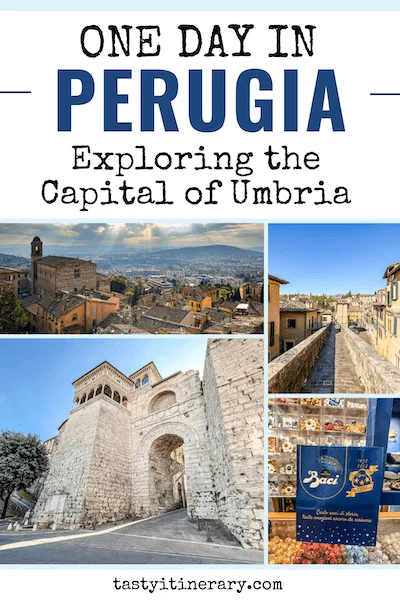
How to spend one day in Perugia? Explore the highlights with these things to do in Perugia in a day.
When planning a trip to Italy, the region of Umbria gets easily forgotten, but it’s one of those regions that deserve to be explored.
After spending 3 days in Tuscany , in Pienza, we decided to cross over the border of the Tuscany region into Umbria. It’s a region that we are highly curious about and a region that easily gets forgotten. From Pienza, it was a little over an hour’s drive.
So, we visited Umbria’s capital city, Perugia.
Where is Perugia, Italy?
Perugia is a city in the region of Umbria, in central Italy. It is one of the largest cities in Umbria and one of the oldest, dating back to the time of the Etruscans. The walled historic city sits on a hill overlooking the valley of the Tiber and is one of the most important cities in central Italy.
It’s also home to one of the oldest universities in Italy, the University of Perugia.
And if you’re looking for a tasty itinerary, chocolate lovers are in for a treat, as Perugia is home to one of Italy’s most famous chocolate factories, Perugina. The famous Baci chocolates that we all love originate from this great city.
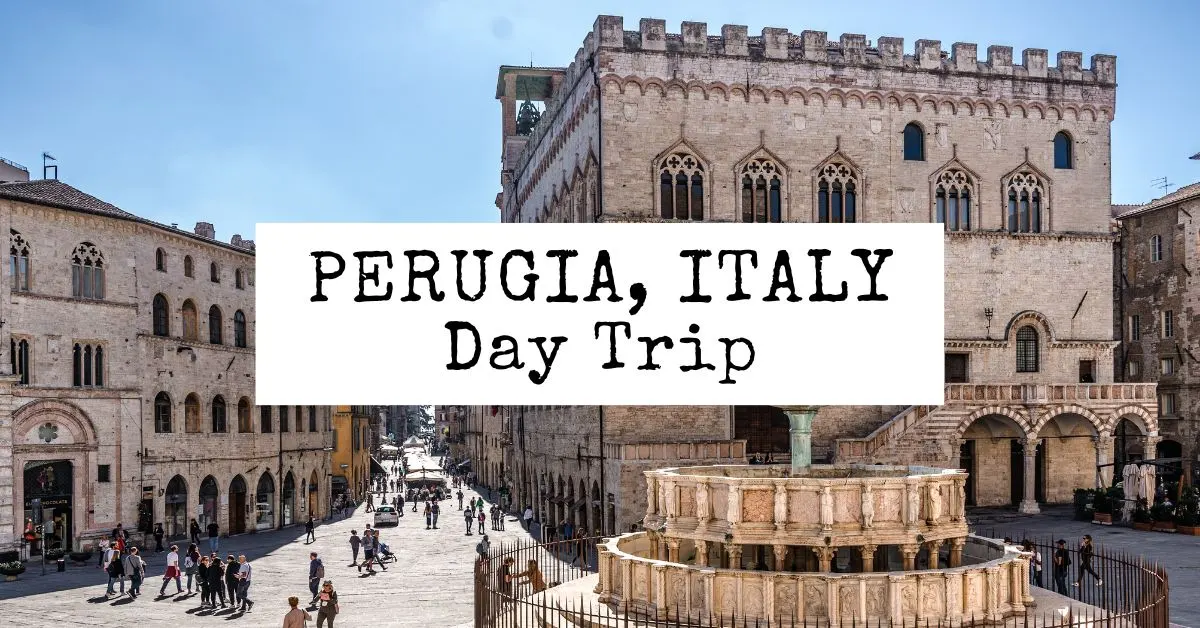
Disclaimer: This post may contain affiliate links, meaning we earn a commission at no extra cost. Please refer to our full disclosure for details.
Chocolate is enough of a reason to visit. However, with just one day in Perugia, you can have your chocolate and explore what this charming city offers. There is plenty of things to do in Perugia, so if one day is all you have, here’s what we recommend.
This article explores one day in Perugia, Italy, how to get to Perugia, and tasty eats not to miss on your tasty itinerary.
Table of Contents
One Day in Perugia
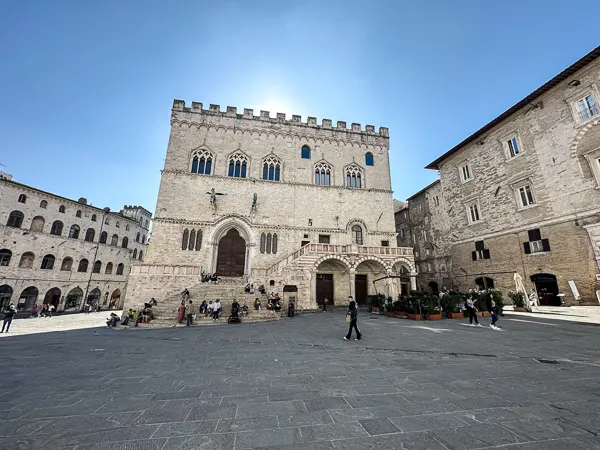
How do I spend a day in Perugia?
When you visit Perugia for the day, you’ll want to explore some of the city’s highlights. Explore the historic city center, stroll along the ancient Roman aqueduct, visit Rocca Paolina, and find the gateways into the city. Don’t leave Perugia without stopping at Perugina for the city’s famous chocolate.
Is Perugia worth visiting?
Yes, Perugia is worth the visit. As one of the oldest cities in the region and Italy, the history alone is worth exploring. University cities are always great to visit as the cities are usually lively, buzzing with energy, and plenty of things to do.
Is Perugia, Italy, a small town?
No, Perugia is not a small town. It’s the largest city in Umbria and one of the largest cities in Italy. Over 160,000 people reside in Perugia , making it the most populated city in Umbria.
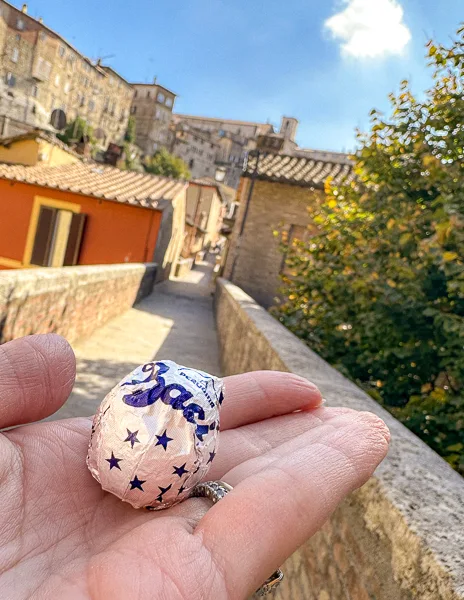
What’s Perugia famous for?
Perugia is famous for its chocolate. Their biggest chocolate manufacturer is Perugina. Baci chocolates are one of the most famous Italian chocolates produced in Perugia.
Things to Do in Perugia in a Day
With one day in Perugia, you can’t see everything, but you can experience the city’s highlights. You can get around the city easily on foot and make your way to the important landmarks we list below.
When we arrived, we were surprised by the size of the city and how busy it was when visiting Italy in October. It had the same liveliness reminiscent of Bologna , probably because it’s another university city.
We made the most of one day by walking around, ticking off some of the city’s highlights, stopping for a panini, and eating too much chocolate.
You can always plan to arrive in Perugia and have a guided tour booked to make the most of your day.
Tour Ideas : Perugia Private Walking Tour [ book here ] Taste Perugia Food Tour Led by Local [ book here ] Perugia 2–Hour Small-Group Walking Tour [ book here ]

Lookout for the Gates & Arches in Perugia
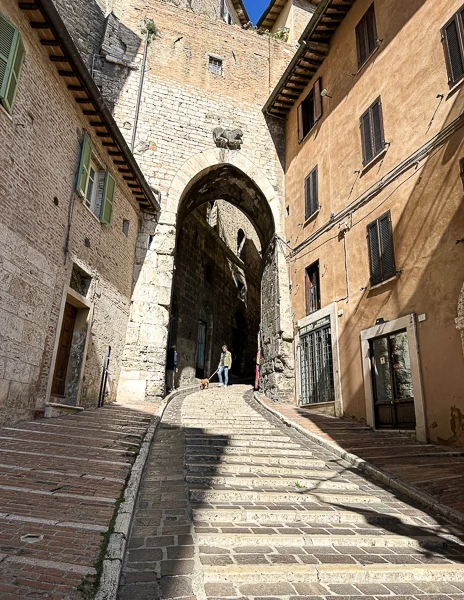
There are different entrances to this walled city. There are 6 gates along the wall, but 22 gates and arches within the city of Perugia. Just seeing and walking through one of these gates and arches is almost like being transported back in time.
You could spend the day discovering them throughout Perugia. It’s one of those historical cities that can be explored one corner at a time if you’re there for more than a day.
Arco Etrusco
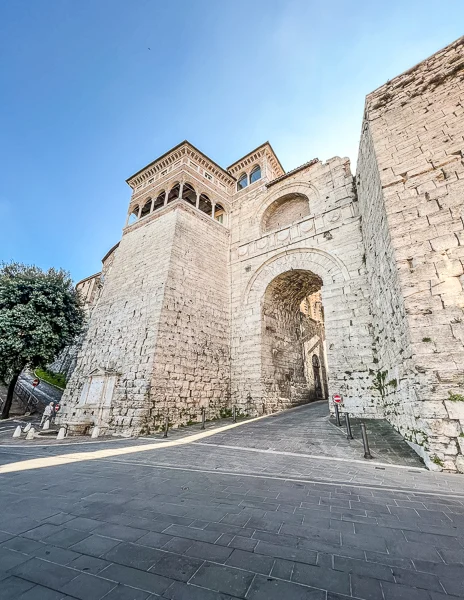
One of the city’s main attractions is the Etruscan Arch, Augustus Gate. Upon seeing it, one cannot help but be astounded by its grandeur. Built in the 3rd century BC, it marks one of the best-preserved Etruscan monuments in the city.
Explore Perugia’s Ancient City Center
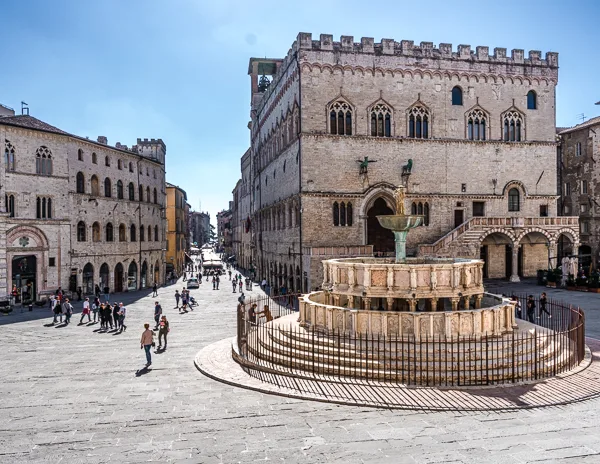
All streets lead to Perugia’s historic city center… or so it felt that way. Just keep going uphill. Every alley or street we went down or around felt like it led us back to the city center.
Perugia’s city center shows how prosperous the city was: its majestic Cathedral, Palazzo dei Priori, Corso Vannucci (the main boulevard), and Piazza IV Novembre.
While exploring the city center, you’ll have to wade through some more touristy areas but don’t let that deter you from exploring. The city is full of hidden gems and historical landmarks.
If you’re looking to do some shopping, the main drag of Perugia, Corso Vannucci, will have all the high-end shops and boutiques.
Visit the Piazza IV Novembre
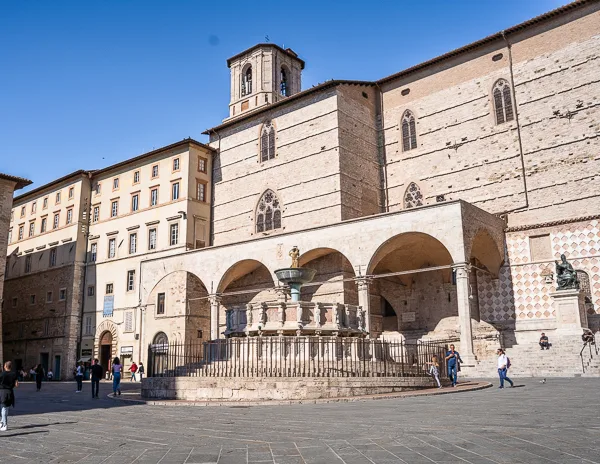
Piazza IV November is one of the most iconic piazzas in town, the heart, and one you won’t miss, as 5 roads in the city center lead you right into this square. You can also see the square as a fork in the road; which street would you like to go down next?
This prominent square is where the city gathers for events and celebrations. You can find the Cattedrale di San Lorenzo, the Palazzo dei Priori, and one of Perugia’s grand attractions, the Fontana Maggiore.
Fontana Maggiore
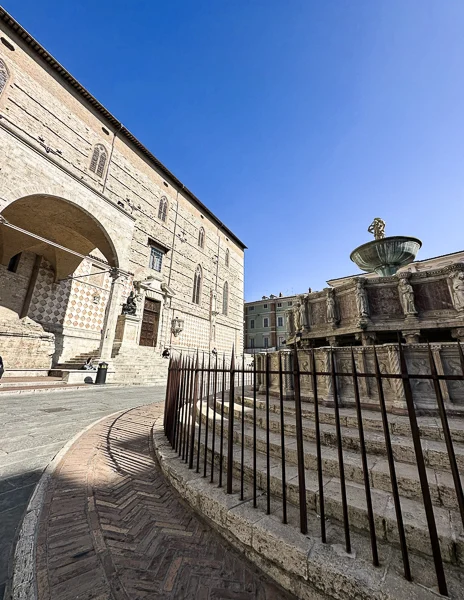
The Fontana Maggiore is one of Perugia’s well-known landmarks. The fountain was built in 1278 and is one of the most unique ones we’ve seen. It is made up of two basins, one on top of the other, the second being held by small columns inside of the bottom of the basin.
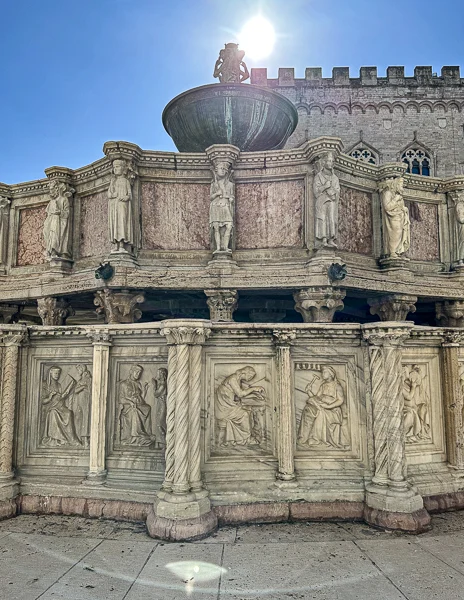
It’s one of those monuments that one should take the time to admire and explore. It’s intricately designed with a mixture of religious symbols and secular figures from the Old Testament, making it one of Perugia’s most stunning sites.
The execution of this fountain coincides with the completion and celebration of the Roman aqueduct.
Quick Lunch at La Bottega
Piazza Francesco Morlacchi 4, 06123 Perugia PG, Italy Google Map It
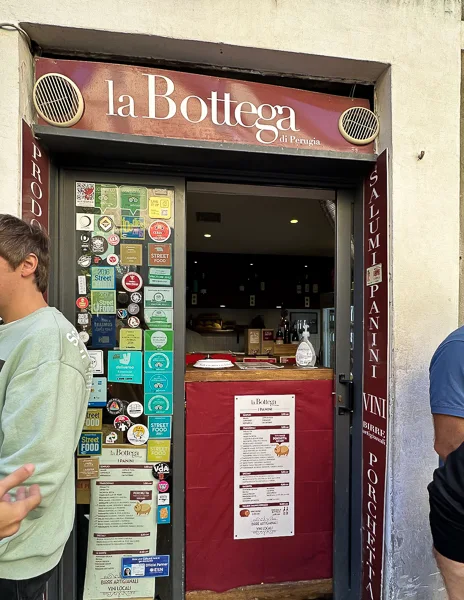
Not far from Piazza IV Novembre is Piazza Morlacchi, where you’ll find La Bottega. Go west and onto Via Maesta delle Volte, follow that down to Piazza Cavolloti, and then left onto Piazza Morlacchi. There you’ll find a few spots to eat.
When you see locals patiently waiting in line and gathering outside an establishment to eat, you have to find out what it is. Timing perfectly with a late lunch, we came across this scene, and everyone was eating paninis—one of the best quick and cheap lunches in Italy.
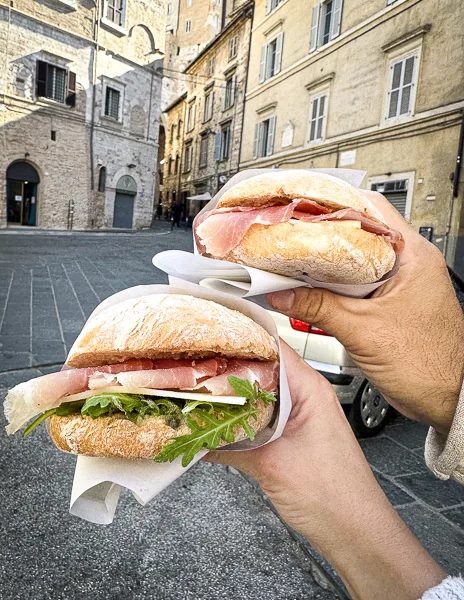
We stood in line and ordered paninis from La Bottega’s menu. These sandwiches were hand-prepared to order. The best part was that it cost us less than 10 euros for two sandwiches and two glasses of water.
This is a great grab-and-go lunch when you’re short on time and want to make the most of your day.
Via dell’Acquedotto
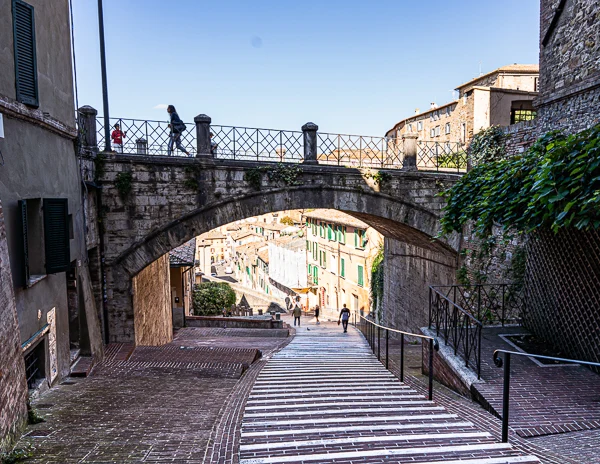
Afterward, we headed to Via dell’Acquedotto to see the Medieval Aqueduct, presently a pedestrian walkway.
Romans engineered the earliest form of the aqueduct, but it was restored many times in the middle of the ages.
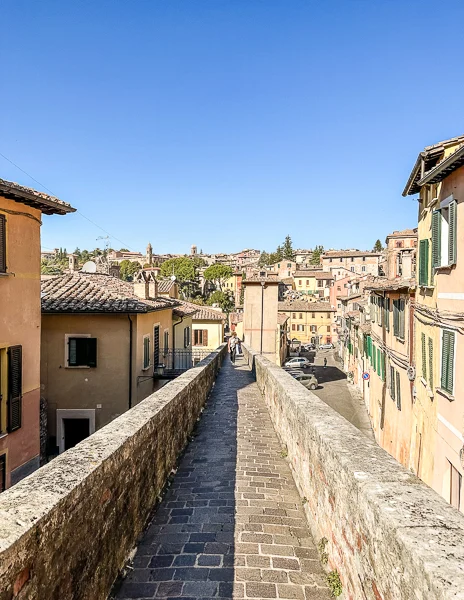
When we read about the aqueduct, for some reason, we were expecting a grand structure. So while it is a cool part of history in Perugia, what is left of the aqueduct is fairly small, and a quick short walk over it.
It is a pretty scene arriving at Via dell’Acquedotto, having a beautiful view of part of the city of Perugia. You can stop here to take photos, or you can continue on your journey across the aqueduct. On the other side, you’ll find a quieter side of Perugia with residential structures and other local businesses outside the touristy areas.
Explore Rocca Paolina
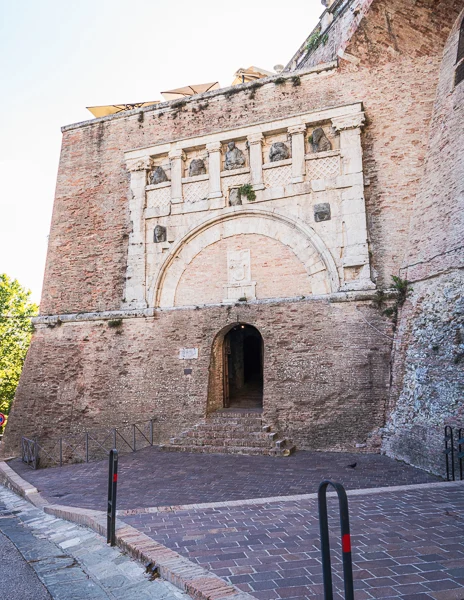
If you still have time in the day, one of the top things to do in Perugia is Rocca Paolina. This fortress was built in 1540 and is one of the most important monuments in Perugia.
This fortress was built in 1540 and later destroyed in the 1800s. 1965, it was rediscovered, and excavations began, bringing back this underground city in Perugia. There are four entrances to Rocca Paolina, and you can walk down one of the many tunnels and explore the chambers, one leading to another in this fortress.
What’s cool about Rocca Paolina is that the escalators built inside take you from one part of the city to another.
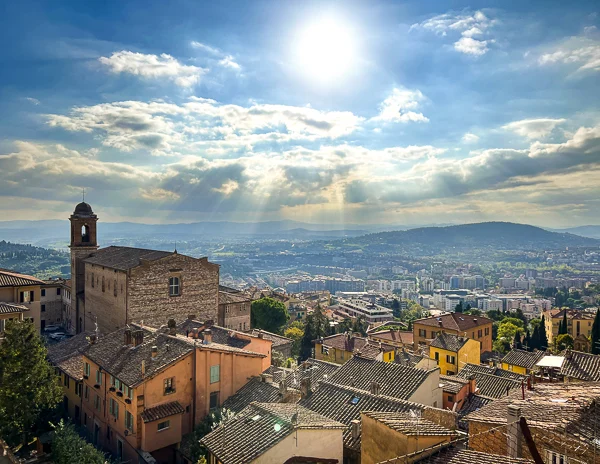
Also, at the top of Rocca Paolina are some incredible views worth stopping for.
Visit the Official Perugina Shop
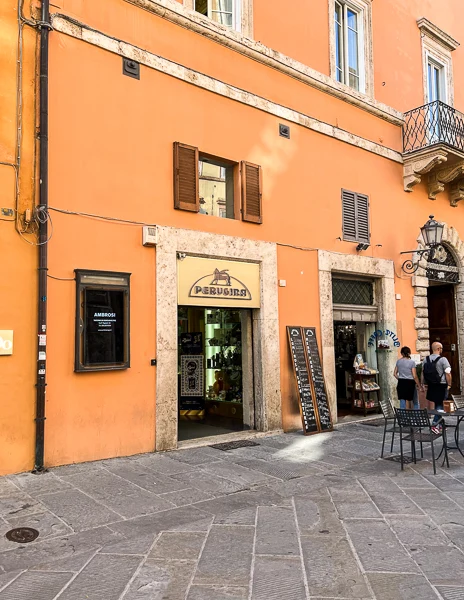
One of the top things to do in Perugia, especially if you’re a chocolate lover, you can’t forget to stop by one of the most famous chocolate shops.
Perugina is one of the best-known chocolate brands in Italy, and one has to buy a few chocolates to eat right then.
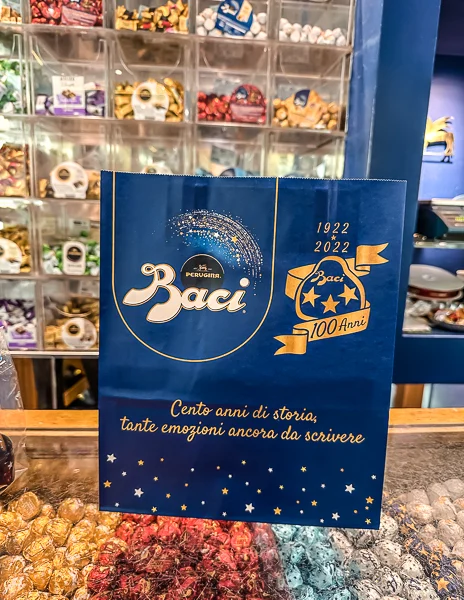
You’ll see Baci chocolates sold all over the city and in different shops, but Perugina is the official shop. You will find Baci chocolates of different flavors, ones you’ve never seen back home. Also, different types of mixed chocolates and confections are only sold in Europe.
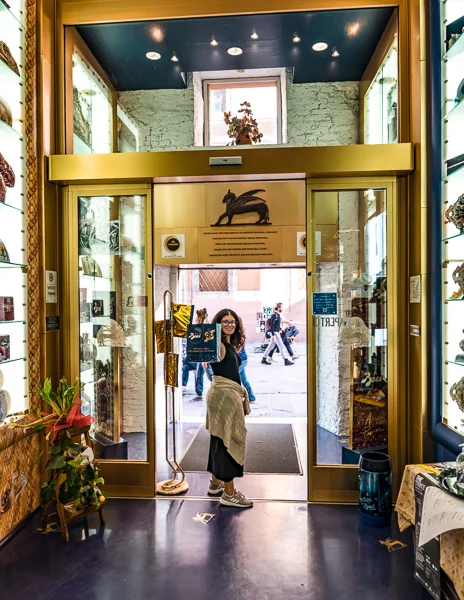
Let’s not forget to buy a few gifts to take home. This is a great spot to shop for edible souvenirs to take back home with you.
The official Perugina chocolate shop is located in Corso Pietro Vannucci, 101, 06123 Perugia PG, Italy ( Google Map It )
Optional: Visit Casa del Cioccolato Perugina
If you plan your day trip to Perugia, you can probably fit this in at the start of your day. Unfortunately, we didn’t think of it until later.
You can reserve a tour of the Perugina Chocolate Factory and Museum, locally known as Casa del Cioccolato Perugina (translating into The House of Chocolate Perugina).
It’s right outside the city center of Perugina. For logistical purposes, plan to tour it either at the start of your one day in Perugia or towards the end of it.
You can book a directly with Perugina .
Other Tour Ideas: Small-Group Tour: Chocolate Factory, Perugia & Spoleto [ book here ] Perugia Private Tour with Lunch & Perugina Chocolate House [ book here]
Other things you can do in Perugia:
- Visit Galleria Nazio nale dell’Umbria
- Visit the National Archaeological Museum of Umbria
- Visit the Cathedral of San Lorenzo
How to Get to Perugia?
Option 1: Car Rental
Having a car rental allows you to explore freely; however, it all depends on how comfortable you are with driving, your itinerary, and if you even need a rental. If you’re staying in a major city with access to a train station, you may not need a car rental to make it to Perugia.
You’ll want to reaccess if you plan to explore the Umbria region. A car rental, in general, would be ideal for driving in the countryside and visiting smaller towns.
Find a car on rentalcars.com .
Option 2: By Train or Bus
- If you stay in a major city, you can easily get to Perugia by train. You can quickly get from one major city to another using Trenitalia or Italo, the main Italian train operators.
- Take the train to Perugia Fontivegge Railway from the station you need to get to the historic center. The fastest way to get to the city center is to take a taxi or the mini-metro.
- Taking a bus is also an option. It all depends on where you’re staying, but there are direct bus transfers to Perugia.
- Book your tickets in advance. Click here for train schedules and info ; it will come up if a bus transfer option is available.
Day Trip Examples:
- Day trip from Florence to Perugia by train is a one-way 1 hr 14 min direct train ride or a 2 hr 25 min bus ride.
- Day trip from Assisi to Perugia is a one-way 22 min train ride.
- Day trip from Siena to Perugia is a one-way, 43-47 min train ride.
- Day trip from Arezzo to Perugia is a one-way, 47-57 min train ride.
- From Rome to Perugia is a 2 hr 42 min train ride one-way or by bus, it’s 2hr 15 mins.
Option 3: Hire a Driver or Book a Guided Tour
One day in Perugia was all that was needed to see the highlights. However, with the amount of history and hidden gems in this city, it deserves more time in the future. If we could do it all over again, we would hire a guide to highlight all the hidden historical facts we may have missed.
BEFORE YOU TRAVEL TO ITALY, CHECK OUT THESE RELATED READS:
- Memorable Experiences in Italy to Add to Your Bucket List
- 10 Alluring Reasons to Visit Italy: Top Travel Destination
- Why Italy in October: 8 Convincing Reasons
- Inspiring Quotes About Italy: Your Next Foodie Destination
Meet Kathy Ava, a food, travel, and cruise writer based in Los Angeles/Pasadena, and the owner and main writer of Tasty Itinerary. With over 20 years of experience planning trips and logistics at her full-time job and for herself, she's become a pro at crafting unforgettable tasty itineraries. She's always on the hunt for delicious, fun travel destinations and cruise itineraries. She firmly believes that life is short and we must make the most of it, so always say yes to dessert.
Leave a Reply Cancel reply
Your email address will not be published. Required fields are marked *
That’s so cool you got to visit here! I’ve always wanted to go ever since I first heard about this city. It looks like such a beautiful area to explore. It’s so cool walking around such a historic area. I love that there are areas in our world that have preserved their history.
Looks like you had a beautiful and yummy day with those paninis and chocolate.😋
You’d love it!

Find cheap flights to Perugia
Search hundreds of travel sites at once for deals on flights to perugia.
Save 21% or more Compare multiple travel sites with one search.
Track prices Not ready to book? Create a price alert for when prices drop.
Filter your deals Choose cabin class, free Wi-Fi and more.
Bundle and save Save money when you bundle your flight + hotel.
Flights to Perugia - Travel Insights & Trends
Get data-powered insights and trends for flights to perugia to help you find the cheapest flights, the best time to fly and much more., what is the cheapest day to fly to perugia, based on kayak data, the cheapest day to fly to perugia is wednesday where tickets can be as cheap as $867. on the other hand, the most expensive day to fly is thursday, where prices are $2,005 on average., how long is the flight to perugia, the duration of your flight to perugia depends on your departure and arrival airports. obviously any flights that include a layover will also be longer. the most popular routes to perugia on kayak are from newark , which takes 8h 15m, new york , which takes 8h 20m, miami , which takes 9h 50m, and los angeles , which takes 11h 45m., when to book flights to perugia, faqs - booking perugia flights, how far is perugia from central perugia.
The city center of Perugia is 6 miles from Perugia.
What is the name of Perugia’s airport?
There is only 1 airport in Perugia, called Perugia (PEG). It can also be referred to as Perugia San Francesco d'Assisi – Umbria Intl, Perugia Sant Egidio Airport,, or Sant Egidio.
How does KAYAK find such low prices on flights to Perugia?
KAYAK is a travel search engine. That means we look across the web to find the best prices we can find for our users. With over 2 billion flight queries processed yearly, we are able to display a variety of prices and options on flights to Perugia.
How does KAYAK's flight Price Forecast tool help me choose the right time to buy my flight ticket to Perugia?
KAYAK’s flight Price Forecast tool uses historical data to determine whether the price for a flight to Perugia is likely to change within 7 days, so travelers know whether to wait or book now.
What is the Hacker Fare option on flights to Perugia?
Hacker Fares allow you to combine one-way tickets in order to save you money over a traditional round-trip ticket. You could then fly to Perugia with an airline and back with another airline.
What is KAYAK's "flexible dates" feature and why should I care when looking for a flight to Perugia?
Sometimes travel dates aren't set in stone. If your preferred travel dates have some wiggle room, flexible dates will show you all the options when flying to Perugia up to 3 days before/after your preferred dates. You can then pick the flights that suit you best.
Which airline offers the most flights to Perugia?
Of the 2 airlines that fly to Perugia, Ryanair offers the most flights, with around 14 per week, followed by Aeroitalia with 12 flights per week.
Top tips for finding cheap flights to Perugia
- Enter your preferred departure airport and travel dates into the search form above to unlock the latest Perugia flight deals.
Prefer to fly non-stop to Perugia Sant Egidio?
Find which airlines fly direct to Sant Egidio, which days they fly and book direct flights.
Nonstop departures
United States to Perugia Sant Egidio
Aeroitalia, Ryanair, Wizz Air Malta
Aeroitalia, Ryanair, +1 more
Aeroitalia, British Airways, Ryanair, +1 more
Aeroitalia, British Airways, +2 more
Aeroitalia, Albawings, Ryanair, +2 more
Aeroitalia, Albawings, +3 more
Aeroitalia, Albawings, British Airways, +2 more
Nonstop returns
Perugia Sant Egidio to United States
Top airline flying to perugia.
Our seats were moved by ticketing agent at Chicago, so we thought we were getting an upgrade. Turns out we were put next to 4 children 2 of which cried or screamed for the entire 7.5 hour flight. It was a terrible experience for us.
The aircraft left 5 hours later than original dipartire time They let all passengers board and sit for 3 hours in a hot air plain with no A/C. Than they made all passengers leave the air plain due to some issues to the engine. Passengers received 1 glass of water the entire time . Than they boarded everyone again and took almost another hour before they took off. I bought these tickets for my 74 years old mother, Julianna Horvathne Kas and my nephew, Balázs Kelemen. Definitely going to request for a compensations!!
During breakfast the fligh attendants missed one side of the plane for tea/coffee. I was on the other side and received tea. Unfortunately my husband and friends did not.
Economy class has no legroom so if you have the money worth to upgrade! Food was absolutely horrible! The crew was super nice!!!!!
The flight was provided by Aer Lingus and our seats were in a poor condition (15A & 15C). They looked like they needed repairing/replacing and were uncomfortable for such a long flight. Also the arm rests on Aer Lingus planes do not lift more than around 45 degrees, instead of the usual 90 degrees upright, meaning you cannot maximum the space between you & your travel companion so as to be more comfortable for such a long flight.
Flights were actually with Aer Lingus outward and American Airlines & Aer Lingus on the return journey. Outward flight with Aer Lingus was good but the return flight with them was not so good as our seats were in a poor condition (15A & 15C) and looked like they needed replacing! The American Airlines flight from Miami to JFK New York was good and the seats were very comfortable and spacious (32D & 32E)
Awful. Delay, lost vacation time and travel time now more than 24h
Awful. Flight delayed and we missed our long flight to Rome. It has been a nightmare and we have still not arrived. It was NOT a weather delay, just poor planning by AA
We left our sons tablet on the British Airways plane And we can’t get a hold of anyone to try to locate it. I have to call multiple numbers.
Boarding was as fast and efficient as possible. The flight crew were amazing and extremely friendly. We enjoyed our flight.
Book Cheap Perugia Plane Tickets
Round-trip flight deals, search by stops, one-way flight deals, flights to perugia, destination:.
Perugia (PEG) Italy
Cabin classes:
Browse origins:.
- Flights »
- United States
Browse destinations:
- Worldwide »
Flight search
- Adults Remove adult 1 Add adult
- Children Aged 2-11 Aged 2 to 11 Remove child 0 Add child
- Infants In seat Remove infant in seat 0 Add infant in seat
- Infants On lap Remove infant on lap 0 Add infant on lap
- Premium economy
Cheap flights to Perugia
Popular airports near perugia.
- Leonardo da Vinci–Fiumicino Airport (FCO) Rome 2 hr 27 min 146 km
- San Francesco d'Assisi Airport (PEG) Perugia 20 min 9 km
- Bologna Guglielmo Marconi Airport (BLQ) Bologna 2 hr 43 min 180 km
- Amerigo Vespucci Airport (FLR) Florence 1 hr 55 min 123 km
When to visit
About perugia, frequently asked questions about flying to perugia, search more flights, more places to fly.
Related Content
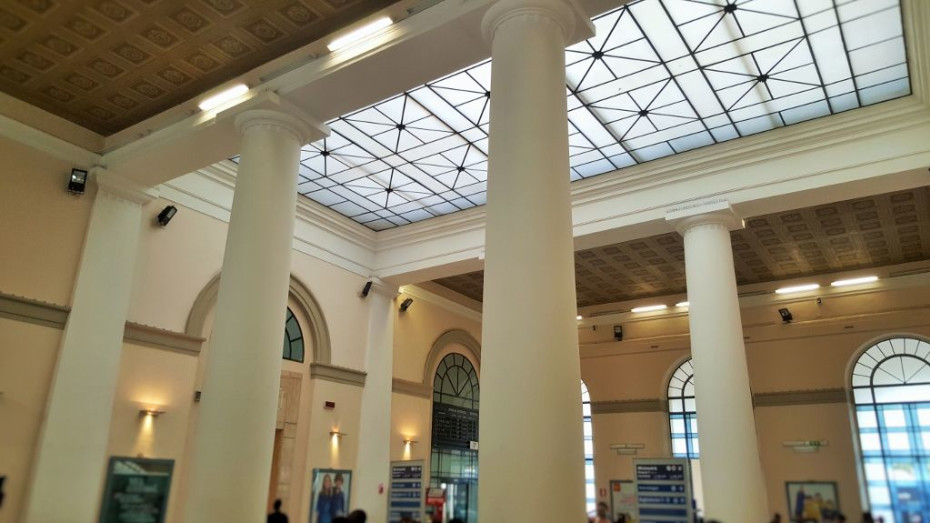
How to travel from Rome to Perugia by train
Share this journey with a friend..., roma / rome to perugia by train.
In common with many Italian rail routes there is a choice of services when making a journey by train from Rome/Roma to Perugia:
If the timing suit sand you want the peace of mind of a reserved seat, take the Intercity (IC) train. Also because limited numbers of the most 'Super Economy' tickets will be made available for the IC train, if you book ahead, it can be a money saver.
The RV trains are more frequent and you can book last minute at the station with the peace of mind that you won't have saved by booking in advance. So if you buy tickets on the travel date, these trains become the cheapest option.
Though this isn't a high speed route, so the Intercity trains are only marginally faster.
Routes you can take to go from Roma / Rome to Perugia
When travelling between most cities by train there is only one logical option, though on other journeys there is a choice between different trains or alternative routes. If different options are available you can use the info to decide which is best for you.
Choose one of the following options:
Looking for connections, route information, option 1: taking the regionale veloce trains, station guides.
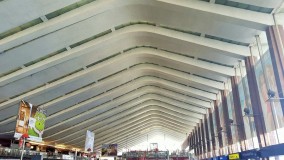
Travel Time (approx)
2hr 27min - 2hr 34min
Travel Info
Mon-Fri = 4 x trains per day Sat/Sun = 3 x trains per day
Purchase Tickets

Trenitalia Guide
Trenitlalia is the national rail operator in Italy and in addition to its cheaper types of ticket ; it also typically offers other discounts available to non-Italians, which include:
- Group Offers , provides for a discount of up to 50% when 3-5 Adults travel together.
- Family Offer for when groups of 2 - 5 people are travelling together and at least one of the party is a aged 11 and under.
- The Children Free Offer is available for journeys by Frecce trains , when groups of 2 - 5 people are travelling together and at least one of the party is a aged 15 and under. Those aged 15 and under travel for free, but the Adults will need to purchase full price 'Base' tickets.

Travel Information
Final Destination: Perugia
All of these trains also call at: Assisi and Perugia Ponte San Giovanni * *The train will call here BEFORE it arrives at the main station Perugia, so if you're heading to Perugia take care NOT to leave the train at this station, it is some distance from the town.
All trains also call at: Roma Tiburtina
Due to the perhaps surprisingly sparse train service on this Rome to Perugia route, it's worth looking up the departure times of these direct RV trains on Trenitalia , even if you will be buying tickets at the station.
Also when you look up the Rome to Perugia train journey on Trenitalia, you will see up to five other journeys per day, which involve making a usually straightforward connection between trains in Foligno.
The alternative Intercity train service:
If you would rather have the peace of mind of travelling in a reserved seat on the Rome to Perugia train journey, you can take the Intercity (IC) train.
It isn't much faster than these RV trains, but on Sundays to Fridays it isn't usually scheduled to depart from Roma Termini until 19:58. On those days of the week it comprises the final train of the day from Rome to Perugia; it doesn't operate on Saturdays.
This is a direct journey
You will be travelling on one of these trains....
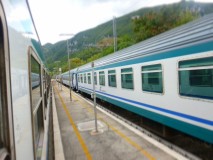
Journey Features
Good to know.
As seats can't be reserved on these RV trains, aim to be waiting on the concourse at Roma Termini, ticket(s) in hand, when the binari (track/platform) that the train will be departing from is confirmed.
If you want to buy tickets at Roma Termini, then it's a good idea to be at the station a minimum of 40 mins before the train departs. Buying tickets from a Trenitalia ticket machine is usually quicker than purchasing at the ticket office, but at busy times there can be lengthy queues for the machines.
On particularly busy trains, finding a spare seat at Roma Tiburtina can be a lottery, so this is a journey on which boarding at Roma Termini is recommended.
Don't forget to stamp your ticket before boarding these RV trains.
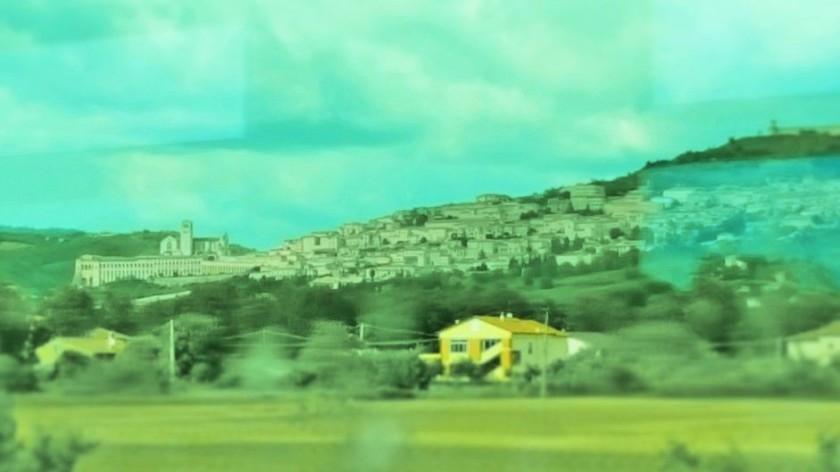
It's a pleasant rather exciting journey by train from Rome to Perugia, through the rolling landscape of central Italy.
Though as the admittedly poor quality image below shows, from the right of the train you can see the Basillica of Saint Francis of Assisi , as the train approaches Assisi.

Book early and save: No - not if you travel by these Regionale Veloce (RV) trains from Rome to Perugia, though you can save by booking in advance for the alternative IC train.
Tickets will cost the same price if purchased at the same station immediately before departure if you travel by these RV trains.
If you will be buying tickets at the station just before departure, tickets for these Regionale Veloce (RGV/RV) trains will be much cheaper than the price of that IC train.
However, if you are booking in advance the price difference with the IC train will be more marginal; and the IC train ticket will include an assigned seat.
Option 2: taking the Intercity train
2hr 15min (approx)
Not Every Day
Sunday - Friday = 1 x train per day This train is not available on Saturdays

Italia Rail Guide
Italiarail lives up to its name by selling tickets for rail journeys within Italy and the core feature of its service is that it is primarily designed to be used by international visitors to Italy. So the English translations of place names are used when looking up journeys and the terms and conditions for using each type of ticket are clearly explained. It also clearly points out the additional costs of upgrading to other classes and types of tickets while spelling out the additional benefits of doing so. Though Italiarail will charge a booking fee, typically of around €3.
The Early Bird service
Italiarail has launched an 'early bird' pre-booking service for journeys by Frecce trains. Tickets can be booked up to a year ahead of travel at a flat-rate price per route, before the tickets have been released for sale by Trenitalia. If when they are placed on sale, the price is cheaper than what you have already paid to Italiarail, it will automatically refund the price difference. Conversely, if the price is more expensive, you won't be charged the price difference. You can also have the peace of mind of securing your seat(s) on the Frecce train(s) when you are first planning a trip. If before the tickets are placed on sale, you decide to change your plans, you can request a refund; but once the tickets are released for sale, you will then be bound by the terms and conditions of the ticket(s) you have booked.

This train will also call at: Assisi and Perugia Ponte San Giovanni * *The train will call here BEFORE it arrives at the main station Perugia, so if you're heading to Perugia take care NOT to leave the train at this station, it is some distance from the town.
This train also calls at: Roma Tiburtina
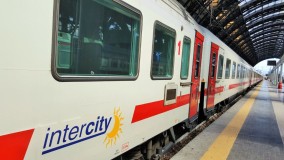
On Sundays to Fridays there are three options for taking a train from Rome to Perugia.
(1) Travelling by this Intercity (IC) train, which is usually scheduled to depart from Roma Termini at 19:55 If you want to travel from Rome to Perugia with the peace of mind of a reserved seat, you have to take this IC train. On Fridays to Sundays it is also the final train of the day from Rome to Perugia.
(2) The slightly more frequent service of Regionale Veloce (RV) trains from Rome to Perugia. They aren't much slower than this Intercity train and they will be cheaper; though the difference in price will be more marginal if you book in advance. They're also the only option if you want to take a direct train from Rome to Perugia and arrive there before 22:00.
(3) Though the most frequent option of all is to take an RV train from Rome to Foligno and then make what should be a straightforward connection, into a train on to Perugia.
The train service from Rome to Perugia is comparatively sparse, because Perugia isn't on the main railway route, which heads north from Rome, hence it not being on a high speed line and therefore having no service of Frecce or Italo trains.
Book early and save: Yes
Online bookings open: 3 months ahead of the travel date
On Fridays to Sundays, this Intercity train from Rome to Perugia is usually scheduled to depart from Roma Termini at 19:55 (it doesn't operate on Saturdays).
It is more expensive than the more frequent alternative service, but difference in price can be less than €5s.
Complimentary seat reservations are also included with the ticket price when booking tickets for this IC train.
The cheapest 'Super Economy' tickets for this journeys tend to still be available when booking only a couple of days ahead. Though if you will be booking at the station on your day of travel, those Regionale Veloce trains will be cheaper.
Please support ShowMeTheJourney
Help keep us advertising and paywall free!
This second version of ShowMeTheJourney is exciting and new, so we are genuinely thrilled that you are here and reading this, but we also need your help.
We’re striving not to let anything get in the way of providing the most useful service possible, hence a facility has been set up with DonorBox which can be used to support the running costs and make improvements.
Instead of advertising or paywalls, your financial support will make a positive difference to delivering an enhanced service, as there’s a lot of ideas which we want to make happen.
So if you have found the info provided here to be useful, please consider saying thank you.
See if there’s a unique journey guide for your trip, featuring info on the trains, tickets & stations.
- Austria by train
- Wien / Vienna
- Belgium by train
- Bruxelles / Brussels
- Czechia by train
- Praha / Prague / Prag
- Denmark by train
- København / Copenhagen
- France by train
- Germany by train
- Frankfurt (Main)
- Köln / Cologne / Koeln
- München / Munich
- Great Britain by train
- Hungary by train
- Italy by train
- Firenze / Florence
- Milano / Milan / Mailand
- Roma / Rome
- Torino / Turin
- Venezia / Venice / Venedig
- Netherlands by train
- Norway by train
- Poland by train
- Warszawa / Warsaw
- Spain by train
- Sweden by train
- Switzerland by train
- Basel / Bâle
- Genève / Geneva
- Zürich / Zurich
- No Matching Cities
- List is empty.

This is one of more than 100 train travel guides available on ShowMeTheJourney , which will make it easier to take the train journeys you want or need to make. As always, all images were captured on trips taken by ShowMeTheJourney.

- Europe by Train
- Journey Guides
- Rail Stations
- Trip Planning
- Travel Articles
- Tips from 100s of journeys
- How to take a night train
- Good to know about daytime trains
- Travelling with Children
- Taking Bikes on Trains
- Travelling with Luggage
- Taking dogs on trains
- Common benefits of first class travel
- Journeys with multiple connections
- Money saving advice
- The best permanent deals and offers
- Intro to seat reservations
- Step-by-step booking guides
- InterRail/Eurail
- Access over 500 rail holidays
- Save 5% on more than 30 Swiss rail holidays
- Book a range of Swiss rail passes
- Buy Half Fare Cards for Switzerland
- Book train tickets with Trainline
- Book rail holidays worldwide with Bookmundi
You are using an outdated browser. Upgrade your browser today or install Google Chrome Frame to better experience this site.
- Section 5 - Leishmaniasis, Visceral
- Section 5 - Onchocerciasis / River Blindness
CDC Yellow Book 2024
Author(s): Kathrine Tan, Francisca Abanyie
Infectious Agent
Transmission, epidemiology, clinical presentation.
INFECTIOUS AGENT: Plasmodium spp.
Multiple countries in Africa, the Americas, and Asia
TRAVELER CATEGORIES AT GREATEST RISK FOR EXPOSURE & INFECTION
PREVENTION METHODS
Avoid insect bites
Use malaria chemoprophylaxis
DIAGNOSTIC SUPPORT
- 770-488-7788 (M–F 9 a.m.–5 p.m. Eastern)
- 770-488-7100 (after hours)
Parasitological diagnosis: DPDx
Malaria in humans is caused by protozoan parasites of the genus Plasmodium , including Plasmodium falciparum , P. malariae , P. ovale , and P. vivax . In addition, zoonotic forms have been documented as causes of human infections and some deaths, especially P. knowlesi , a parasite of Old World (Eastern Hemisphere) monkeys, in Southeast Asia.
Plasmodium species are transmitted by the bite of an infective female Anopheles mosquito. Occasionally, transmission occurs by blood transfusion, needle sharing, nosocomially, organ transplantation, or vertically from mother to fetus. Malaria transmission occurs in large areas of Africa, Latin America, and parts of the Caribbean, Eastern Europe, the South Pacific, and in Asia including South Asia, Southeast Asia, and the Middle East ( Map 5-12 , Map 5-13 , and Map 5-14 ).
Map 5-12 Malaria-endemic destinations in the Americas & the Caribbean
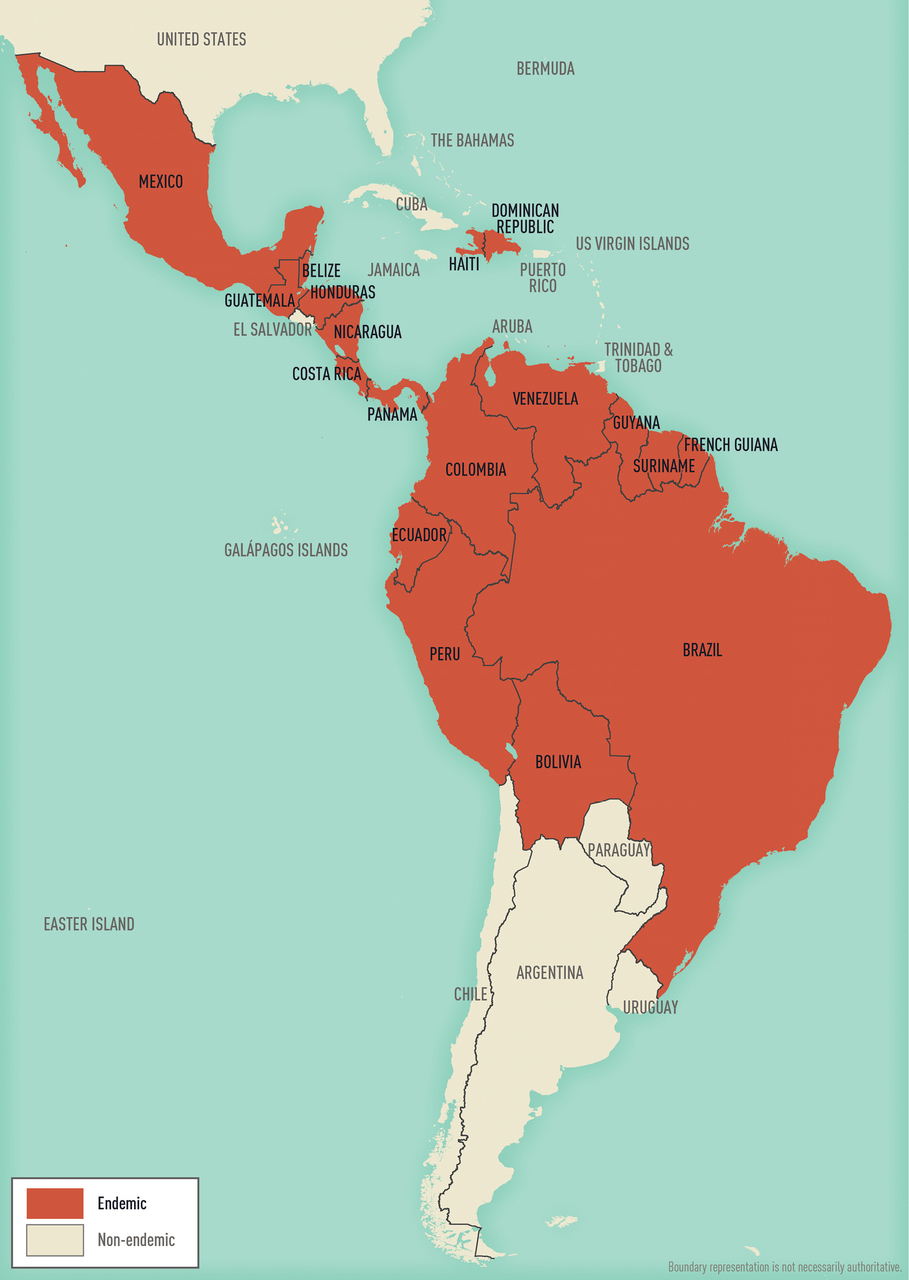
View Larger Figure
Malaria-endemic destinations are labeled using black font; destinations not endemic for malaria are labeled using gray font. Countries with areas endemic for malaria are shaded completely even if transmission occurs only in a small part of the country. For more specific within-country malaria transmission information, see Section 2, Yellow Fever Vaccine & Malaria Prevention Information, by Country .
Map 5-13 Malaria-endemic destinations in Africa & the Middle East
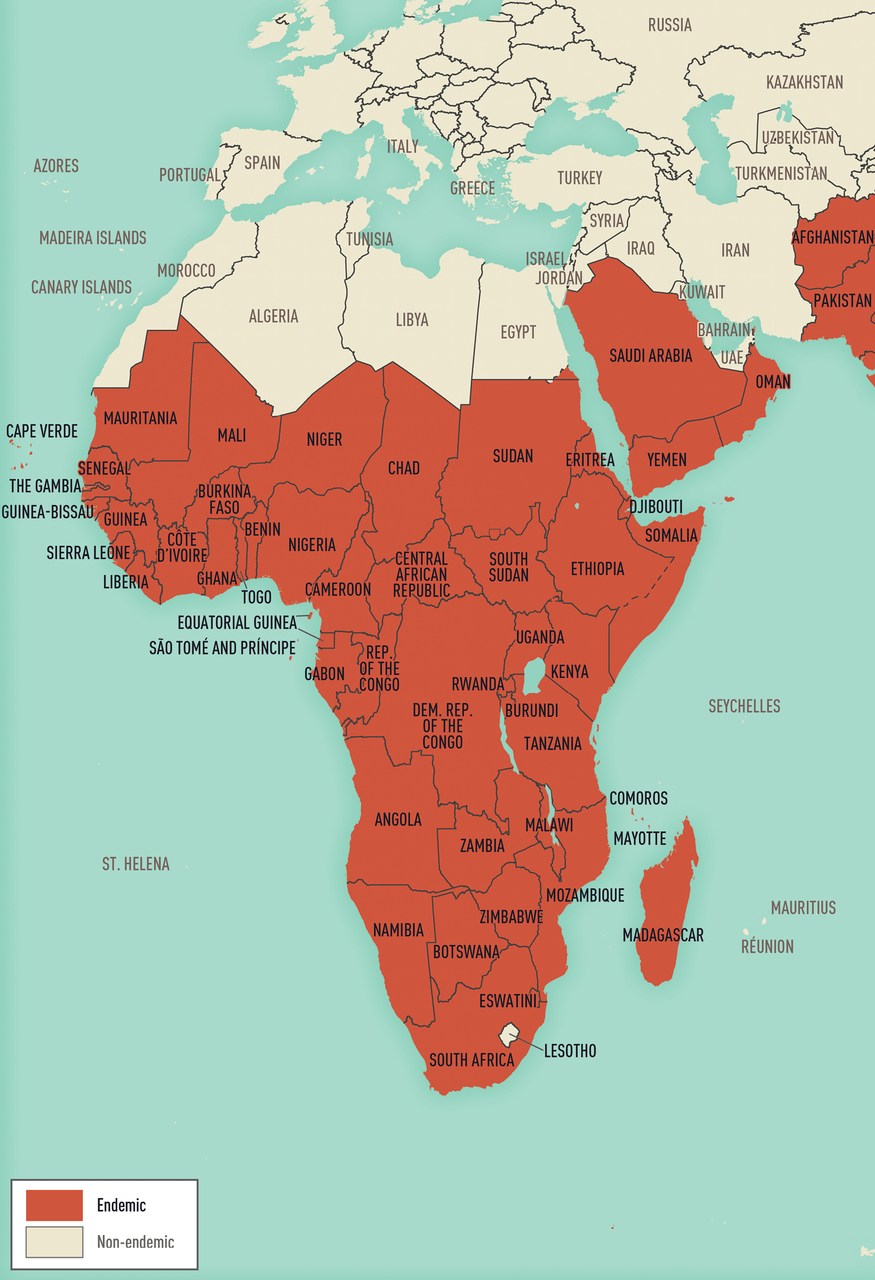
Map 5-14 Malaria-endemic destinations in Asia & Oceania
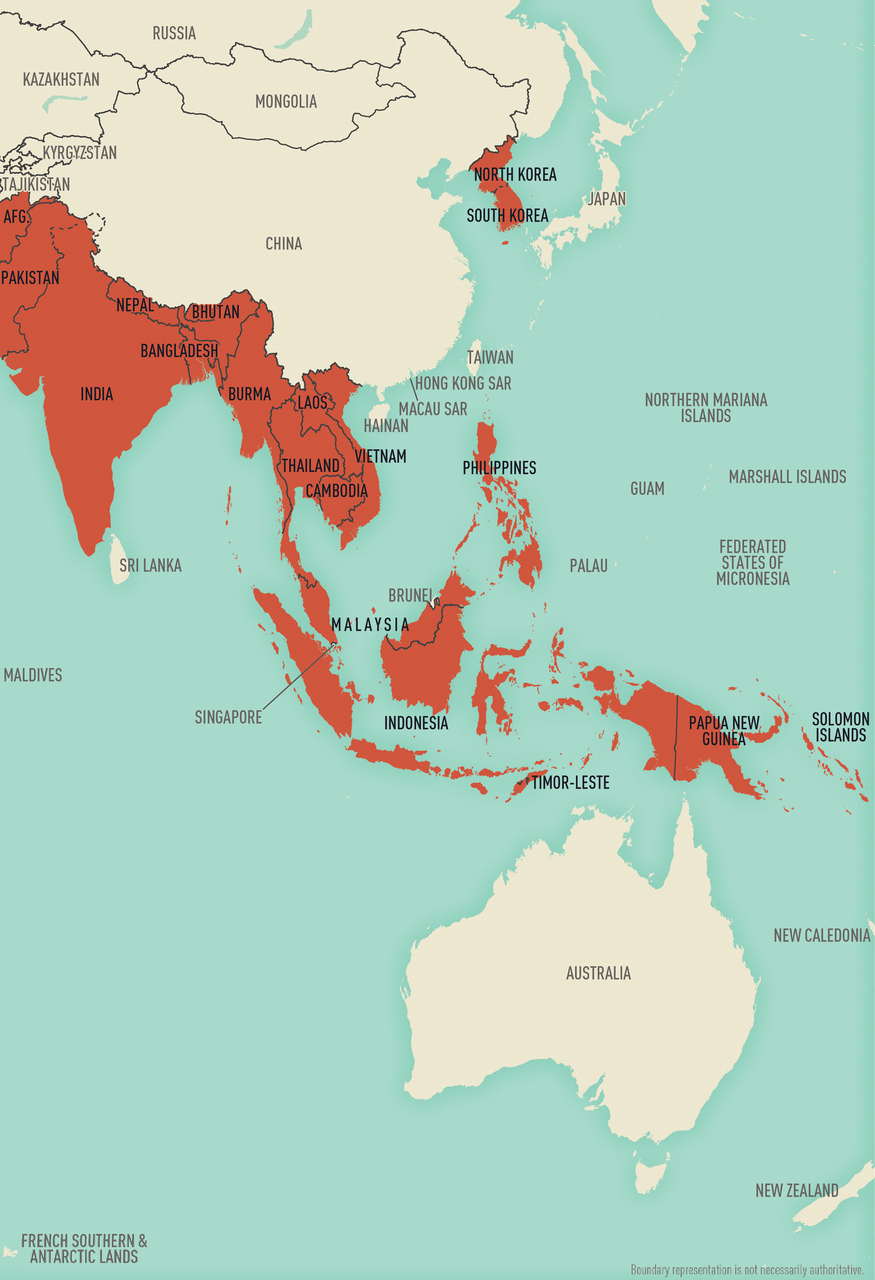
Malaria is a major international public health problem. According to the World Health Organization (WHO) World Malaria Report 2019, >90 countries reported ≈228 million infections and ≈405,000 deaths in 2018. Travelers going to malaria-endemic countries are at risk of contracting the disease, and almost all the ≈2,000 cases of malaria that occur each year in the United States are imported.
The risk of acquiring malaria differs substantially from traveler to traveler and from region to region, even within a single country. This variability is a function of the intensity of transmission within the various regions and the itinerary, duration, season, and type of travel. Risk also varies by travelers’ adherence to mosquito precautions and prophylaxis recommendations. In 2016, 2,078 cases of malaria (including 7 deaths) were diagnosed in the United States and its territories and were reported to the Centers for Disease Control and Prevention (CDC). Of cases for which country of acquisition was known, 85% were acquired in Africa, 9% in Asia, 5% in the Caribbean and the Americas, and 1% in Oceania or the Eastern Mediterranean. Of US residents with malaria who reported a reason for travel, 69% were visiting friends and relatives.
Information about malaria transmission in specific countries is derived from various sources, including WHO (see Sec. 2, Ch. 5, Yellow Fever Vaccine & Malaria Prevention Information, by Country ). The information presented here was accurate at the time of publication; the risk for malaria can change rapidly and from year to year, however, because of changes in local weather conditions, mosquito vector density, and prevalence of infection. See updated information CDC website.
Malaria is characterized by fever and influenza- like symptoms, including chills, headache, myalgias, and malaise; symptoms can occur intermittently. In severe disease, acute kidney injury, acute respiratory distress syndrome, mental confusion, seizures, coma, and death can occur. Malaria symptoms can develop as early as 7 days after being bitten by an infectious mosquito in a malaria-endemic area and as late as several months or more after exposure. Suspected or confirmed malaria, especially P. falciparum , is a medical emergency requiring urgent intervention, because clinical deterioration can occur rapidly and unpredictably. See Box 5-10 for frequently asked clinical questions.
Box 5-10 Frequently asked clinical questions
How do i address concerns about side effects from prophylaxis.
- Prophylaxis can be started earlier if the traveler has concerns about tolerating a particular medication. For example, mefloquine can be started 3–4 weeks in advance to allow potential adverse events to occur before travel. If unacceptable side effects develop, the clinician has time to change the medication before the traveler’s departure.
- The drugs used for antimalarial prophylaxis are generally well tolerated. Side effects can occur, however. Minor side effects usually do not require stopping the drug. Clinicians should determine if symptoms are related to the medicine and make a medication change if needed.
WHAT SHOULD A TRAVELER DO IF THEY MISS A DOSE OF PROPHYLAXIS?
- Compared with drugs with short half-lives, which are taken daily, drugs with longer half-lives, which are taken weekly, offer the advantage of a wider margin of error if the traveler is late with a dose.
- For a weekly drug, prophylactic blood levels can remain adequate if the dose is only 1–2 days late. If this is the case, the traveler can take a dose as soon as possible, then resume weekly doses on the originally scheduled day. If the traveler is >2 days late, blood levels might not be adequate. The traveler should take a dose as soon as possible. The weekly doses should resume at this new day of the week (the next dose is 1 week later, then weekly thereafter).
- For a daily drug, if the traveler is 1–2 days late, protective blood levels are less likely to be maintained. The traveler should take a dose as soon as possible and resume the daily schedule at the new time of day.
WHAT HAPPENS IF TOO HIGH A DOSE OF PROPHYLAXIS IS TAKEN?
- Overdose of antimalarial drugs, particularly chloroquine, can be fatal. Medications should be stored in childproof containers out of reach of infants and children.
ISN’T MALARIA A TREATABLE DISEASE? WHY NOT CARRY A TREATMENT DOSE OF ANTIMALARIALS INSTEAD OF TAKING MALARIA PROPHYLAXIS?
- Malaria could be fatal even when treated, which is why prevention is always preferable to treating infections after they occur.
WHAT SHOULD BE DONE IF FEVER DEVELOPS WHILE TRAVELING IN A MALARIA-ENDEMIC AREA?
- Malaria and other potentially life-threatening infections acquired during travel could be fatal if treatment is delayed. Travelers should promptly seek medical help and continue to take malaria prophylaxis while in the malaria-endemic area.
WHAT SHOULD BE DONE IF A TRAVELER WHO TOOK MALARIA PROPHYLAXIS DEVELOPS FEVER AFTER RETURNING FROM THEIR TRIP?
- Malaria prophylaxis, while highly effective, is not 100% effective. Travelers should be advised to seek medical care immediately if fever develops, report their travel history, get tested for malaria, and get treated promptly if infection is confirmed.
- Malaria smear or a rapid diagnostic test must be performed, and results obtained immediately (within a few hours). These tests should not be sent out to reference laboratories that take days to weeks to return results. Empiric treatment with antimalarial drugs is not recommended because the malaria smear provides critical information for appropriate treatment. If a patient has an illness suggestive of severe malaria and a compatible travel history in an area where malaria transmission occurs, and malaria testing is not immediately available, start treatment as soon as possible, even before the diagnosis is established. See CDC recommendations for malaria treatment .
Travelers with symptoms of malaria should seek medical evaluation as soon as possible, even if still traveling. Consider malaria in any patient with a febrile illness who has recently returned from a malaria-endemic country. Diagnostic assistance is available from state public health laboratories or CDC. The CDC malaria laboratory can assist in speciating malaria by blood smear microscopy, or confirm species by PCR testing. The CDC laboratory also can assess malaria parasites for mutations that confer resistance to medications. Serologic testing , used in certain situations (e.g., case investigations), can also be done by CDC laboratories.
In the United States, malaria is a notifiable disease. Health care providers must report cases of malaria diagnosed via microscopy or PCR in the United States and its territories to local or state health departments. See more information on reporting malaria .
Blood Smear Microscopy
Blood smear microscopy remains the most important method for malaria diagnosis. Microscopy can provide immediate information about the presence of parasites, allow quantification of the density of the infection, and allow determination of the species of the malaria parasite—all of which are necessary for providing the most appropriate treatment. Tests should be performed immediately when ordered by a health care provider, and microscopy results should be available as soon as possible, ≤24 hours of the patient’s presentation. Assistance with speciation of malaria on smears is available from state health departments or CDC.
In resource-limited settings, and particularly in sub-Saharan Africa, overdiagnosis and the rate of false-positive microscopy for malaria can be high; warn travelers that a local diagnosis of malaria could be incorrect. In such cases, acutely ill travelers should seek the best available medical services and continue their prophylaxis regimen until they have a definitive diagnosis.
Rapid Diagnostic Testing
Rapid diagnostic tests (RDTs) for malaria detect antigens derived from malaria parasites. Malaria RDTs are immunochromatographic tests that most often use a dipstick or cassette format and provide results in 2–15 minutes. RDTs offer a useful alternative to microscopy in situations where reliable microscopic diagnosis is not immediately available. Although RDTs can detect malaria antigens within minutes, they have several limitations. RDTs cannot distinguish between all Plasmodium species that affect humans, they might be less sensitive than expert microscopy or PCR for diagnosis, they cannot quantify parasitemia, and an RDT-positive test result might persist for days or weeks after an infection has been treated and cleared. Thus, RDTs are not useful for assessing response to therapy. Furthermore, in some areas, mutations are increasingly being observed in malaria parasites, resulting in an absence of the malaria antigen usually detected by many RDTs, including the only RDT used in the United States. The absence of this parasite antigen in peripheral blood can lead to false-negative RDT test results.
Both positive and negative RDT results must always be confirmed by microscopy. Microscopy confirmation of the RDT result should occur as soon as possible, because the information on the presence, density, and parasite species is critical for optimal management of malaria. The US Food and Drug Administration (FDA) has approved an RDT (the BinaxNOW Malaria test) for hospital and commercial laboratory use; the test is not approved for use by clinicians or patients. Laboratories that do not provide in-house, on-the-spot microscopy services should maintain a stock of malaria RDTs so that they will be able to perform immediate malaria diagnostic testing when needed.
PCR Testing
PCR tests also are available to detect malaria parasites. These tests are more sensitive than routine microscopy, but results are not usually available as quickly as microscopy results, thus limiting the utility of PCR for acute diagnosis and initial clinical management. Use of PCR testing is encouraged to confirm the species of malaria parasite and detect mixed infections.
Malaria can be treated effectively if treatment begins early in the disease; delaying therapy, however, can have serious or even fatal consequences. Specific treatment options depend on the species of malaria, the severity of infection, the likelihood of drug resistance (based on where the infection was acquired), the patient’s age, and whether the patient is pregnant or breastfeeding.
See detailed CDC recommendations for malaria treatment . For assistance with the diagnosis or treatment of malaria, call the CDC Malaria Hotline (770-488-7788 or toll-free at 855-856-4713) from 9 a.m. to 5 p.m. Eastern Time. After hours, on weekends, or on holidays, call the CDC Emergency Operations Center at 770-488-7100 and ask the operator to contact the subject matter expert on call for the Malaria Branch. In addition, consult a clinician specializing in travel or tropical medicine or infectious diseases.
Travelers who decline to take prophylaxis, who choose a suboptimal drug regimen (e.g., chloroquine in an area with chloroquine-resistant P. falciparum ), or who require a less-than-optimal drug regimen for medical reasons are at increased risk for acquiring malaria and then needing prompt treatment while abroad. Medications not used in the United States to treat malaria (e.g., halofantrine, sulfadoxine-pyrimethamine) are widely available abroad. CDC does not recommend halofantrine for treatment because of documented adverse cardiac events, including deaths. These adverse events have occurred in people with and without preexisting cardiac problems, and both in the presence and absence of other antimalarial drugs. Sulfadoxine-pyrimethamine is not recommended because of widespread drug-resistant Plasmodium .
Reliable Supply of Malaria Treatment
Some travelers who take effective prophylaxis but who will be in remote areas might decide, in consultation with their travel health provider, to also carry a reliable supply of a full course of an approved malaria treatment regimen. In the event a traveler carrying a reliable supply is diagnosed with malaria, they will have immediate access to an approved treatment.
CDC recommends that the reliable supply be acquired in the United States, so clinicians can consider the traveler’s other medical conditions or medications when selecting an antimalarial drug and to avoid the possibility of travelers obtaining counterfeit drugs in the local pharmacy or market, or depleting local resources. In rare instances when access to medical care is not available and the traveler develops a febrile illness consistent with malaria, the reliable supply medication can be self-administered presumptively. Advise travelers that self-treatment of a possible malarial infection is only a temporary measure, and that prompt medical evaluation is imperative.
Two malaria treatment regimens available in the United States can be prescribed as a reliable supply for self-treatment: atovaquone-proguanil and artemether-lumefantrine. To treat malaria, CDC recommends against using the same (or related) drug that has been taken for prophylaxis. For example, atovaquone-proguanil can be used as a reliable supply medication by travelers who are not taking atovaquone-proguanil for prophylaxis. See Table 5-26 for dosing recommendations.
Table 5-26 Reliable supply regimens for malaria treatment 1
PEDIATRIC DOSE
ATOVAQUONE-PROGUANIL 2 Adult tablets:
- Atovaquone 250 mg
- Proguanil 100 mg
Pediatric tablets:
- Atovaquone 62.5 mg
- Proguanil 25 mg
4 adult tablets taken orally (as a single daily dose) for 3 consecutive days
Weight-based daily dose taken orally (as a single daily dose) for 3 consecutive days
5–8 kg: 2 pediatric tablets 9–10 kg: 3 pediatric tablets 11–20 kg: 1 adult tablet 21–30 kg: 2 adult tablets 31–40 kg: 3 adult tablets >41 kg: 4 adult tablets
Contraindicated in people with severe renal impairment (creatinine clearance <30 mL/min).
Not recommended for people taking atovaquone-proguanil prophylaxis.
Not recommended for children weighing <5 kg, or people who are pregnant or breastfeeding infants weighing <5 kg.
ARTEMETHER-LUMEFANTRINE 2 One tablet
- Artemether 20 mg
- Lumefantrine 120 mg
ADULT & PEDIATRIC DOSE
Weight-based treatment schedule for both adult and pediatric patients. Patients should take an initial dose, followed by a second dose 8 hours later, then 1 dose twice a day for the next 2 days (total of 6 oral doses over 3 days).
5 kg to <15 kg: 1 tablet per dose 15 kg to <25 kg: 2 tablets per dose 25 kg to <35 kg: 3 tablets per dose ≥35 kg: 4 tablets per dose
Not recommended for people taking mefloquine prophylaxis.
Not recommended for children weighing <5 kg, or people breastfeeding infants weighing <5 kg.
1 A reliable supply is a complete course of an approved malaria treatment regimen obtained in the United States before travel. A reliable supply is not counterfeit or substandard; will not interact adversely with the patient’s other medicines, including malaria chemoprophylaxis; will not deplete local resources in the destination country.
2 If used for presumptive self-treatment, patients should seek medical care as soon as possible.
Malaria prevention consists of a combination of mosquito avoidance measures and chemoprophylaxis. Prevention measures must address all malaria species in the travel area and apply to both short-term and long-term travelers. Although highly efficacious, interventions are not 100% effective, so all febrile persons returning from malaria-endemic areas should be tested for malaria even if they took chemoprophylaxis.
Preventing malaria involves striking a balance between effectiveness and safety: ensuring that all people at risk for infection use the recommended prevention measures, and preventing rare occurrences of adverse effects. Conduct an individual risk assessment for every traveler by collecting a detailed travel itinerary, including countries, specific areas to be visited in those countries (e.g., cities, rural areas, both), types of accommodation, season, and style of travel. Modify the risk assessment depending on traveler characteristics (e.g., pregnancy, underlying health conditions) and malaria characteristics at the destination (e.g., intensity of transmission, local parasite resistance to drugs). Depending on the level of risk, it might be appropriate to recommend no specific interventions, mosquito avoidance measures only, or mosquito avoidance measures plus chemoprophylaxis.
Several factors increase a traveler’s risk for malaria. Travel, even for short periods of time, to areas with intense malaria transmission can result in infection. Malaria transmission is not distributed homogeneously throughout a country, so review the exact itinerary to determine if travel will occur in highly endemic areas. In countries where malaria is seasonal, travel during peak transmission season also increases risk. Travelers going to rural areas or staying in accommodations without screens or air conditioning also will be at greater risk. The greatest risk for malaria is associated with first- and second-generation immigrants living in nonendemic countries who return to their countries of origin to visit friends and relatives (VFRs). VFR travelers might perceive themselves to be at no risk because they grew up in a malaria-endemic country and consider themselves immune to the disease. Tolerance acquired through continuous exposure to malaria is quickly lost, however; consider VFRs to have the same risk as other nonimmune travelers (see Sec. 9, Ch. 9, Visiting Friends & Relatives: VFR Travel ). Also remind travelers that they could become infected even if they had malaria before, and they still need to take preventive measures.
Mosquito Avoidance Measures
Because of the nocturnal feeding habits of Anopheles mosquitoes, malaria transmission occurs primarily between dusk and dawn. Travelers can reduce contact with mosquitoes by remaining in enclosed air-conditioned rooms or well-screened areas, sleeping under mosquito nets (preferably insecticide-treated), using an effective insecticide spray or mosquito coils in living and sleeping areas during evening and nighttime hours, and wearing clothes that cover most of the body.
All travelers should use an effective mosquito repellent, such as those that contain DEET (see Sec. 4, Ch. 6, Mosquitoes, Ticks & Other Arthropods ). Repellents should be applied to exposed parts of the skin. If travelers are also wearing sunscreen, they should apply sunscreen first and insect repellent second. In addition to using a topical insect repellent, a permethrin-containing product can be applied to mosquito nets and clothing for additional protection against mosquitoes. Mosquito repellant–impregnated clothing also is available.
Chemoprophylaxis
Choosing a drug to prevent malaria.
All recommended primary prophylaxis regimens involve taking a medicine before, during, and after travel to an area with malaria. Beginning the drug before travel allows the antimalarial agent to be in the blood before the traveler is exposed to malaria parasites. In choosing a prophylaxis regimen before travel, the traveler and the travel health provider should consider several factors, including the presence of antimalarial drug resistance in the area of travel, length of travel, the patient’s other medical conditions, allergy history, other medications prescribed or already being taken (to assess possible drug interactions), potential side effects, and the cost of the antimalarial. Long-term travelers, defined as people who travel for ≥6 months, have additional considerations (see Box 5-11 ). Table 5-27 lists some of the benefits and limitations of medicines used for malaria prophylaxis; see additional information about choosing a malaria prophylaxis regimen .
Recommendations for drugs to prevent malaria by country of travel can be found in Sec. 2, Ch. 5, Yellow Fever Vaccine & Malaria Prevention Information, by Country . Recommended drugs for each country are listed in alphabetical order and have comparable efficacy in that country. When >1 drug is recommended, Table 5-27 can help with the decision-making process. No antimalarial drug is 100% protective; therefore, travelers must combine prophylaxis with mosquito avoidance and personal protective measures (e.g., insect repellent, long sleeves, long pants, sleeping in a mosquito-free setting, using an insecticide-treated mosquito net).
Table 5-27 Malaria chemoprophylaxis: prescribing considerations
REASONS TO CONSIDER USING THIS DRUG
REASONS TO CONSIDER AVOIDING THIS DRUG
ATOVAQUONE-PROGUANIL
Good for last-minute travelers because the drug is started 1–2 days before travel.
Some people prefer to take a daily medicine.
Good choice for shorter trips because the traveler takes the medicine for only 7 days after leaving malaria-endemic area, rather than for 4 weeks.
Well tolerated and side effects uncommon.
Pediatric tablets are available and might be more convenient.
Cannot be used by people who are pregnant or who are breastfeeding a child that weighs <5 kg.
Cannot be taken by people with severe renal impairment.
Tends to be more expensive than some of the other options, especially for long trips.
Some people (including children) would rather not take medicine every day.
CHLOROQUINE
Some people would rather take medicine weekly.
Good choice for long trips because it is taken only weekly.
Some people are already taking hydroxychloroquine chronically for rheumatologic conditions; in those instances, they might not have to take an additional medicine.
Can be used in all trimesters of pregnancy.
Cannot be used in areas with chloroquine or mefloquine resistance.
Can exacerbate psoriasis.
Some people would rather not take a weekly medication.
For short trips, some people would rather not take medication for another 4 weeks after leaving malaria-endemic areas.
Not a good choice for last-minute travelers, because drug needs to be started 1–2 weeks before travel.
DOXYCYCLINE
Tends to be the least expensive antimalarial drug.
People already taking doxycycline chronically to prevent acne do not have to take an additional medicine.
Doxycycline also can prevent other infections (e.g., rickettsial infections, leptospirosis); thus, might be preferred by people planning to camp, hike, and swim in fresh water where risk is high
Cannot be used by people who are pregnant or who are breastfeeding a child, or by children aged <8 years.
Some people would rather not take medicine every day.
People prone to getting vaginal yeast infections when taking antibiotics might prefer taking a different medicine.
People might want to avoid the increased risk of sun sensitivity.
Some people are concerned about the potential of getting an upset stomach from doxycycline.
Can be used in all trimesters of pregnancy and during breastfeeding.
Cannot be used in areas with mefloquine-resistant Plasmodium spp.
Cannot be used in patients with certain psychiatric conditions; some travelers without psychiatric conditions would prefer not taking a medication with known neuropsychiatric side effects.
Cannot be used in patients with a seizure disorder.
Not recommended for people with cardiac conduction abnormalities.
Not a good choice for last-minute travelers because drug needs to be started ≥2 weeks before travel.
One of the most effective drugs for prevention of P. vivax; thus, a good choice for travel to places with >90% P. vivax .
Good choice for shorter trips because the traveler takes the medicine for 7 days after leaving a malaria-endemic area, rather than for 4 weeks.
Cannot be used in patients with G6PD deficiency.
Cannot be used in patients who have not been tested for G6PD deficiency.
Costs and delays associated with getting a quantitative G6PD test might prohibit testing; however, the test only has to be done once. After a normal G6PD level is verified and documented, the test does not have to be repeated the next time primaquine or tafenoquine is considered.
Cannot be used by people who are pregnant.
Cannot be used by people who are breastfeeding unless the infant has also been tested for G6PD deficiency.
Some people are concerned about the potential of getting an upset stomach from primaquine.
TAFENOQUINE
One of the most effective drugs for prevention of P. vivax malaria but also prevents P. falciparum .
Good choice for shorter trips because the traveler takes the medicine once, 1 week after leaving malaria-endemic area, rather than for 4 weeks.
Good for last-minute travelers because the drug is started 3 days before travel.
Cannot be used in people with G6PD deficiency.
Costs and delays associated with getting a quantitative G6PD test might prohibit testing; however, the test only has to be done once. After a normal G6PD level is verified and documented, the test does not have to be repeated the next time tafenoquine or primaquine is considered.
Cannot be used by children.
Not recommended for patients with psychotic disorders.
Abbreviations: G6PD, glucose-6-phosphate-dehydrogenase
Box 5-11 Malaria prevention & prophylaxis considerations for the long-term traveler (travel >6 months)
Considerations.
- Malaria prevention measures are the same for both short- and long-term travelers.
- Longer stays mean longer duration of exposure and increased risk of acquiring malaria.
- Travelers’ attention to mosquito avoidance can wane over time.
- Travelers might not adhere to a lengthy course of malaria prophylaxis due to forgetfulness, fear of side effects, and the possible declining sense of risk and need over time.
- Travelers might move between highly endemic or low endemic areas within a country or region.
- Travelers might have a decreased sense of risk and concern about malaria after engaging in local conversations and lore, particularly regarding malaria immunity over time.
- Travelers who become ill with malaria in countries with limited access and quality of health care might not receive appropriate or effective treatment.
ADDITIONAL ADVICE FOR LONG-TERM TRAVELERS
- Travelers should not count on being able to obtain safe, reliable malaria prophylaxis medication abroad; strongly advise that before leaving the United States they purchase enough medication to last them for the entire duration of their travel to malaria-endemic areas.
- Emphasize continued adherence to and safety of malaria prophylaxis drugs.
- Develop a plan for seeking immediate care when ill with fever, including where to get promptly tested and treated for malaria.
- Advise travelers to purchase travel insurance, including contingencies for medical evacuation.
- Consider having a reliable supply of a treatment dose of antimalarial drugs available in case malaria is diagnosed while traveling.
Medications Used for Prophylaxis
Atovaquone-proguanil.
Atovaquone-proguanil (Malarone) is a fixed combination of the drugs atovaquone and proguanil. Prophylaxis should begin 1–2 days before travel to malaria-endemic areas; the medication should then be taken daily, at the same time each day, while in the malaria-endemic areas, and daily for 7 days after leaving the endemic areas (see Table 5-28 for recommended dosages). Atovaquone-proguanil is well tolerated, and side effects are rare. The most common adverse effects reported in people using atovaquone-proguanil for prophylaxis or treatment are abdominal pain, nausea, vomiting, and headache.
Atovaquone-proguanil is not recommended for prophylaxis in children weighing <5 kg (11 lb), pregnant people, people breastfeeding infants <5 kg, or patients with severe renal impairment (creatinine clearance <30 mL/min). Proguanil can increase the effect of warfarin, so travelers might need international normalized ratio monitoring or adjustment of warfarin dosage. No data are available, however, regarding the clinical impact of taking atovaquone-proguanil and warfarin at the same time.
Table 5-28 Malaria chemoprophylaxis: dosing information
INDICATIONS
DOSING / CONTRAINDICATIONS / PRECAUTIONS
Prophylaxis in all malaria-endemic areas
Adult tablets:
1 adult tablet taken orally, 1×/day
Weight-based daily dosing schedule (taken orally, 1×/day) 5 kg to <8 kg: 1/2 pediatric tablet 8 kg to <10 kg: 3/4 pediatric tablet 10 kg to <20 kg: 1 pediatric tablet 20 kg to <30 kg: 2 pediatric tablets 30 kg to <40 kg: 3 pediatric tablets ≥40 kg: 1 adult tablet
Begin taking 1–2 days before travel to malaria-endemic areas.
Take 1×/day, at the same time each day, while in malaria-endemic areas. Continue taking 1×/day for an additional 7 days after leaving endemic areas.
Take with food or a milky drink.
A pharmacist might need to prepare and dispense partial tablet doses in individual capsules, as described in the text.
Prophylaxis only in areas with chloroquine-sensitive malaria
300 mg base (500 mg salt) taken orally, once a week
5 mg/kg base (8.3 mg/kg salt), up to a maximum dose of 300 mg base (500 mg salt), taken orally, 1×/week
Begin taking 1–2 weeks before travel to malaria-endemic areas.
Take 1×/week, on the same day each week, while in malaria-endemic areas.
Continue taking 1×/week for another 4 weeks after leaving endemic areas.
100 mg taken orally, 1×/day
≥8 years of age: 2.2 mg/kg, up to a maximum dose of 100 mg, taken orally, 1×/day
Take 1×/day, at the same time each day, while in malaria-endemic areas. Continue taking 1×/day for another 4 weeks after leaving endemic areas.
Contraindicated in children aged <8 years and in people who are pregnant.
HYDROXY-CHLOROQUINE
An alternative to chloroquine for prophylaxis only in areas with chloroquine-sensitive malaria
310 mg base (400 mg salt) taken orally, 1×/week
5 mg/kg base (6.5 mg/kg salt), up to a maximum dose of 310 mg base (400 mg salt), taken orally, 1×/week
Prophylaxis in areas with mefloquine-sensitive malaria
228 mg base (250 mg salt) taken orally, 1×/week
Weight-based weekly dosing schedule (taken orally, 1×/week) ≤9 kg: 4.6 mg/kg base (5 mg/kg salt) >9–19 kg: 1/4 tablet >19–30 kg: 1/2 tablet >30–45 kg: 3/4 tablet >45 kg: 1 tablet
Begin taking ≥2 weeks before travel to malaria-endemic areas.
Contraindicated in people allergic to mefloquine or related compounds (quinidine, quinine) and in people with active depression, a recent history of depression, generalized anxiety disorder, psychosis, schizophrenia, other major psychiatric disorders, or seizures.
Use with caution in people with psychiatric disturbances or a previous history of depression.
PRIMAQUINE 1
Prophylaxis for short-duration travel to areas with principally P. vivax . Terminal prophylaxis (presumptive antirelapse therapy) to decrease the risk for relapses of P. vivax and P. ovale .
30 mg base (52.6 mg salt) taken orally, 1×/day. Same dose used for both primary and terminal prophylaxis; duration of therapy differs.
0.5 mg/kg base (0.8 mg/kg salt), up to maximum dose of 30 mg base (52.6 mg salt), taken orally, 1×/day Same dose for used both primary and terminal prophylaxis; duration of therapy differs.
Terminal prophylaxis indicated for people with prolonged exposure to P. ovale , P. vivax , or both. Take daily for 14 days after departure from the malaria-endemic area.
Contraindicated in people with G6PD deficiency.
Also contraindicated during pregnancy and breastfeeding unless the breastfed infant has a documented normal G6PD level.
TAFENOQUINE 1
200 mg orally
Not indicated for use in children
Begin taking 3 days before travel to malaria-endemic areas. Take 1×/week, on the same day each week, while in malaria-endemic areas. Take 1 additional dose 1 week after leaving endemic areas. Contraindicated in people with G6PD deficiency. Also contraindicated during pregnancy and breastfeeding unless the breastfed infant has a documented normal G6PD level.
1 Before prescribing primaquine or tafenoquine to any patient, document a normal G6PD level using a quantitative test.
Chloroquine & Hydroxychloroquine
Chloroquine phosphate or hydroxychloroquine sulfate (Plaquenil) can be used to prevent malaria only in destinations where chloroquine-resistant Plasmodium spp. are not active (see Sec. 2, Ch. 5, Yellow Fever Vaccine & Malaria Prevention Information, by Country ). Prophylaxis should begin 1–2 weeks before travel to malaria-endemic areas. Travelers should continue taking the drug once a week, on the same day of the week, during travel in malaria-endemic areas, and for 4 weeks after they leave endemic areas (see Table 5-28 for recommended dosages).
Reported side effects of chloroquine and hydroxychloroquine include blurred vision, dizziness, gastrointestinal disturbance, headache, insomnia, and pruritus, but generally, these effects do not require travelers to discontinue the drug. High doses of chloroquine (e.g., those used to treat rheumatoid arthritis) have been associated with retinopathy; this serious side effect appears to be extremely unlikely when chloroquine is used for routine weekly malaria prophylaxis. Chloroquine and related compounds reportedly can exacerbate psoriasis. People who experience uncomfortable side effects after taking chloroquine might tolerate the drug better by taking it with meals. As an alternative, a traveler experiencing side effects might better tolerate the related compound, hydroxychloroquine sulfate.
Doxycycline
Doxycycline prophylaxis should begin 1–2 days before travel to malaria-endemic areas. Doxycycline should then be taken once a day, at the same time each day, during travel in malaria-endemic areas and daily for 4 weeks after the traveler leaves endemic areas. Insufficient data exist on the antimalarial prophylactic efficacy of related compounds (e.g., minocycline, commonly prescribed for the treatment of acne). People on a long-term regimen of minocycline who need malaria prophylaxis should stop taking minocycline 1–2 days before travel and start doxycycline instead. Minocycline can be restarted after the full course of doxycycline is completed (see Table 5-28 for recommended dosages).
Doxycycline can cause photosensitivity, usually manifested as an exaggerated sunburn reaction. The risk for such a reaction can be minimized by avoiding prolonged, direct exposure to the sun and by using sunscreen (see Sec. 4, Ch. 1, Sun Exposure ). In addition, doxycycline use is associated with an increased frequency of vaginal yeast infections.
Gastrointestinal side effects (nausea, vomiting) can be minimized by taking the drug with a meal or by specifically prescribing doxycycline monohydrate or the enteric-coated doxycycline hyclate, rather than the generic doxycycline hyclate, which is often less expensive. To reduce the risk for esophagitis, advise travelers to swallow the medicine with sufficient fluids and to avoid taking doxycycline shortly before going to bed.
Doxycycline is contraindicated in people with an allergy to tetracyclines, in pregnant people, and in infants and children aged <8 years. Vaccination with the oral typhoid vaccine Ty21a should be completed ≥24 hours before taking a dose of doxycycline.
Mefloquine prophylaxis should begin ≥2 weeks before travel to malaria-endemic areas. Travelers should continue taking the drug weekly, on the same day each week, during travel in malaria-endemic areas and for 4 weeks after leaving endemic areas (see Table 5-28 for recommended dosages).
At prophylactic doses, mefloquine has been associated with rare but serious adverse reactions (e.g., psychosis, seizures); these reactions are more frequent with the higher doses used for treatment. Other side effects reported in prophylaxis studies include abnormal dreams, anxiety disorder, depression, dizziness, gastrointestinal disturbance, headache, insomnia, and visual disturbances. Other neuropsychiatric disorders occasionally reported include aggressive behavior, agitation or restlessness, confusion, encephalopathy, forgetfulness, hallucinations, mood changes, panic attacks, paranoia, and sensory and motor neuropathies (e.g., ataxia, paresthesia, tremors). On occasion, psychiatric symptoms have been reported to continue long after mefloquine has been stopped. FDA also includes a boxed warning about rare reports of persistent dizziness after mefloquine use.
Mefloquine is contraindicated for travelers with a known hypersensitivity to the drug or related compounds (e.g., quinidine, quinine) and in people with active depression, a recent history of depression, generalized anxiety disorder, psychosis, schizophrenia and other major psychiatric disorders, or seizures. Mefloquine should be avoided in people with psychiatric disturbances or a history of depression.
A review of available data suggests that mefloquine can be used safely in people concurrently taking beta-blockers if they have no underlying arrhythmia. Mefloquine is not recommended for people with cardiac conduction abnormalities, however. Any traveler receiving a prescription for mefloquine must also receive a copy of the FDA medication guide [PDF].
Primaquine can cause potentially life-threatening hemolysis in people with glucose-6-phosphate-dehydrogenase (G6PD) deficiency. Rule out G6PD deficiency with a quantitative laboratory test before prescribing primaquine to patients.
Primaquine phosphate has 2 distinct uses for malaria prevention in people with normal G6PD levels: primary prophylaxis in areas with primarily P. vivax , and terminal prophylaxis for travelers who have had prolonged exposure in malaria-endemic areas. Among people with normal G6PD levels taking primaquine, the most common adverse event is gastrointestinal upset; this occurs most commonly if the drug is taken on an empty stomach, and can be minimized or eliminated if it is taken with food.
Primary Prophylaxis
When taken for primary prophylaxis, primaquine should be taken 1–2 days before travel to malaria-endemic areas, daily (at the same time each day) while in the malaria-endemic area, and daily for 7 days after leaving the area (see Table 5-28 for recommended dosages).
Terminal Prophylaxis
In addition to primary prophylaxis, terminal prophylaxis (also known as presumptive antirelapse therapy) generally is indicated for long-term travelers (e.g., military personnel, missionaries, Peace Corps volunteers) with prolonged exposure to P. ovale or P. vivax malaria. Terminal prophylaxis involves taking primaquine toward the end of the exposure period (or immediately thereafter) for the presumptive purpose of eliminating hypnozoites (dormant liver stages) of P. ovale or P. vivax , thereby preventing relapses or delayed-onset clinical presentations of malaria. Because most malaria-endemic areas of the world (except the Caribbean) have ≥1 species of relapsing malaria, travelers to these areas have some risk for acquiring either P. ovale or P. vivax , although the actual risk for an individual traveler is difficult to define.
When indicated, travelers should take primaquine for 14 days after leaving a malaria-endemic area, concurrently with their primary prophylaxis medication. If chloroquine, doxycycline, or mefloquine are used for primary prophylaxis, prescribe primaquine for travelers to take during the last 2 weeks of postexposure prophylaxis. When atovaquone-proguanil is used for primary prophylaxis, travelers can take primaquine during the final 7 days of atovaquone-proguanil, and then for an additional 7 days. If concurrent administration of primary and terminal prophylaxis is not feasible, instruct travelers to take primaquine after completing their primary prophylaxis medication. Primary prophylaxis with primaquine or with tafenoquine (see the following section) obviates the need for terminal prophylaxis.
Tafenoquine
Tafenoquine can cause potentially life-threatening hemolysis in people with G6PD deficiency. Rule out G6PD deficiency with a quantitative laboratory test before prescribing tafenoquine to patients.
Tafenoquine (Arakoda 100 mg tablets) can be used to prevent malaria in adults (see Table 5-28 for recommended dosages). Travelers should take a daily loading dose of tafenoquine for 3 days before leaving for a malaria-endemic area; starting 7 days after the loading dose is complete, they should take a weekly maintenance dose while in the malaria-endemic area; then take a final dose in the week after leaving the malaria-endemic area. Doses should be taken on the same day each week.
Tafenoquine is contraindicated in pregnant people and during breastfeeding. Avoid prescribing tafenoquine for people with a history of psychotic disorder; rare psychiatric adverse events have been observed in people with a history of psychotic disorder using higher doses of tafenoquine. The most common adverse events reported with use of tafenoquine are dizziness, gastrointestinal disturbances, headache, and clinically insignificant decreases in hemoglobin. Tafenoquine should be taken with food.
As of 2020, CDC no longer recommends tafenoquine for terminal prophylaxis of P. ovale or P. vivax malaria.
Prophylaxis for Infants, Children & Adolescents
All children traveling to malaria-endemic areas should use recommended prevention measures, which often include taking an antimalarial drug. In the United States, antimalarial drugs are not available in liquid formulation and can taste bitter. Calculate pediatric doses carefully according to the patient’s body weight, but never exceed the adult dose. Pharmacists can pulverize tablets and prepare gelatin capsules for each measured dose. If a child is unable to swallow capsules or tablets, parents should prepare the child’s medication dose by breaking open the gelatin capsule or crushing the pill and mixing the drug with a small amount of something sweet (e.g., condensed milk, chocolate syrup, chocolate spread) to ensure the entire dose is delivered to the child. Giving the dose on a full stomach can minimize stomach upset and vomiting.
Atovaquone-proguanil can be used as prophylaxis for infants and children weighing ≥5 kg (11 lb); prophylactic dosing for children weighing <11 kg (24 lb) constitutes off-label use in the United States. Chloroquine and mefloquine are options for infants and children of all ages and weights, depending on drug resistance at the destination. Doxycycline can be used for children aged ≥8 years. Primaquine can be used for children who are not G6PD-deficient and who are traveling to areas with principally P. vivax. Pediatric dosing regimens are included in Table 5-28 .
Prophylaxis During Pregnancy
Malaria infection can be more severe in pregnant than in nonpregnant people. Malaria increases the risk for adverse pregnancy outcomes, including premature birth, spontaneous abortion, and stillbirth; thus, because no prophylaxis regimen is completely effective, advise people who are pregnant or likely to become pregnant to avoid travel to areas with malaria transmission if possible (see Sec. 7, Ch. 1, Pregnant Travelers ). If travel to a malaria-endemic area cannot be deferred, an effective prophylaxis regimen and mosquito avoidance measures are essential.
Pregnant people traveling to areas where chloroquine-resistant P. falciparum has not been reported can take chloroquine prophylaxis. Chloroquine has not been found to have harmful effects on the fetus when used in the recommended doses for malaria prophylaxis; therefore, pregnancy is not a contraindication for malaria prophylaxis with chloroquine or hydroxychloroquine.
For travel to areas with known chloroquine-resistant Plasmodium , mefloquine is the only medication recommended for malaria prophylaxis during pregnancy. Studies of mefloquine use during pregnancy have found no indication of adverse effects on the fetus.
Atovaquone-proguanil is not recommended for use during pregnancy because of limited availability of data on its safety, and because other options are available. If other antimalarial drug options are not feasible, however, clinicians and patients should weigh the options, risks, and benefits of using atovaquone-proguanil to make the best decision for the patient. Doxycycline is contraindicated for malaria prophylaxis during pregnancy because of the risk for adverse effects seen with tetracycline, a related drug, on the fetus. These adverse effects include discoloration and dysplasia of the teeth and inhibition of bone growth. Neither primaquine nor tafenoquine should be used during pregnancy; both drugs can be passed transplacentally to a G6PD-deficient fetus and cause hemolytic anemia in utero.
People planning to become pregnant can use the same medications recommended for use during pregnancy (chloroquine or mefloquine, depending on the area of travel). CDC does not make recommendations about delaying pregnancy after the use of malaria prophylaxis medicines. If the traveler or their health care provider wishes to decrease the amount of antimalarial drug in the body before conception, however, Table 5-29 provides information on the half-lives of the recommended malaria prophylaxis medicines. After 2 half-lives, ≈25% of the drug remains in the body, ≈6% remains after 4 half-lives, and ≈2% remains after 6 half-lives.
Table 5-29 Malaria chemoprophylaxis: half-lives
Prophylaxis during breastfeeding.
The quantities of antimalarial drugs excreted in the breast milk of lactating people are insufficient to provide adequate protection to nursing infants. Therefore, infants who require prophylaxis should receive the recommended dosages of antimalarial drugs listed in Table 5-28 . Because chloroquine and mefloquine can be prescribed safely to infants, infants also can be safely exposed to the small amounts excreted in breast milk. Data about the use of doxycycline in lactating people are very limited; most experts, however, consider the theoretical possibility of adverse events to the infant to be remote.
Although no information is available on the amount of primaquine or tafenoquine that enters human breast milk, test both the person breastfeeding and the infant for G6PD deficiency before initiating chemoprophylaxis with either one of these drugs. Because data are not yet available on the safety of atovaquone-proguanil prophylaxis in infants weighing <5 kg (11 lb), CDC does not recommend this drug to prevent malaria in people who are breastfeeding infants weighing <5 kg. Atovaquone-proguanil can, however, be used to treat people who are breastfeeding infants of any weight when the potential benefit outweighs the potential risk to the infant (e.g., treating a breastfeeding person who has acquired P. falciparum malaria in an area of multidrug-resistant strains and who cannot tolerate other treatment options).
Travel to Areas with Chloroquine-Resistant Malaria
Chloroquine-resistant P. falciparum is found in all parts of the world except the Caribbean and countries west of the Panama Canal. Although chloroquine-resistant P. falciparum predominates in Africa, it is found in combination with chloroquine-sensitive P. vivax malaria in South America and Asia. Chloroquine-resistant P. vivax has been confirmed only in Papua New Guinea and Indonesia. For destinations with known chloroquine-resistant Plasmodium spp., in addition to mosquito avoidance measures, prescribe atovaquone-proguanil, doxycycline, mefloquine, or tafenoquine as prophylaxis.
Travel to Areas with Chloroquine-Sensitive Malaria
Areas with chloroquine-sensitive Plasmodium spp. include many Latin American countries where malaria predominantly is caused by P. vivax . Chloroquine-sensitive P. falciparum is present in the Caribbean and Central American countries west of the Panama Canal. For destinations with known chloroquine-sensitive Plasmodium spp., in addition to mosquito avoidance measures, the many effective prophylaxis options include chloroquine, atovaquone-proguanil, doxycycline, mefloquine, and tafenoquine. In countries where P. vivax predominates, primaquine is also an option.
Travel to Areas With Mefloquine-Resistant Malaria
Mefloquine-resistant P. falciparum has been confirmed in Southeast Asia on the borders of Thailand with Burma (Myanmar) and Cambodia, in the western provinces of Cambodia, in the eastern states of Burma on the border between Burma and China, along the borders of Burma and Laos, and in southern Vietnam. For destinations with known mefloquine-resistant Plasmodium spp., in addition to mosquito avoidance measures, prophylaxis options are atovaquone-proguanil, doxycycline, and tafenoquine.
Travel to Areas With Limited Malaria Transmission
For destinations where malaria cases occur sporadically and risk for infection to travelers is considered low, CDC recommends that travelers use mosquito avoidance measures only, and no chemoprophylaxis (see Sec. 2, Ch. 5, Yellow Fever Vaccine & Malaria Prevention Information, by Country ).
Changing Medications as a Result of Side Effects During Prophylaxis
Medications recommended for malaria prophylaxis have different modes of action that affect the parasites at different stages of the life cycle. Thus, if the medication needs to be changed because of side effects before a full course has been completed, some special considerations exist (see Table 5-30 ).
Table 5-30 Malaria chemoprophylaxis: changing medications due to side effects
Obtaining medications overseas.
Medications recommended for malaria prophylaxis might be available at overseas destinations. Combinations of these medications and additional drugs that are not recommended might be commonly prescribed and used in other countries, however. Strongly discourage travelers from obtaining prophylaxis medications while abroad. The quality of these products is not known; products might be produced under substandard manufacturing practices, be counterfeit, contain contaminants, not be protective, or be dangerous. Additional information on medications obtained while traveling can be found in Sec. 6, Ch. 3, . . . perspectives: Avoiding Poorly Regulated Medicines & Medical Products During Travel , and on the FDA website .
Blood Donation After Travel to Malaria-Endemic Areas
People who have been in an area where malaria transmission occurs should defer donating blood after returning from the malaria-endemic area to prevent transmission of malaria through blood transfusion (see Table 5-31 ).
Risk assessments can differ between travel health providers and blood banks. A travel health provider advising a traveler going to a country with relatively low malaria transmission for a short period of time and engaging in low-risk behaviors might suggest the traveler use only mosquito bite precautions and no prophylaxis. Upon the traveler’s return, however, a blood bank might still choose to defer blood donations from that traveler for 1 year because of travel to an area where transmission occurs.
Table 5-31 US Food and Drug Administration recommendations for deferring blood donation in people returning from malaria-endemic areas
CDC website: Malaria
The following authors contributed to the previous version of this chapter: Kathrine R. Tan, Paul M. Arguin
Bibliography
Andrejko KL, Mayer RC, Kovacs S, Slutsker E, Bartlett E, Tan KR, Gutman JR. The safety of atovaquone-proguanil for the prevention and treatment of malaria in pregnancy: a systematic review. Travel Med Infect Dis. 2019;27:20–6.
Angelo KM, Libman M, Caumes E, Hamer DH, Kain KC, Leder K, et al. Malaria after international travel: a GeoSentinel analysis, 2003–2016. Malar J. 2017;16(1):293.
Boggild AK, Parise ME, Lewis LS, Kain KC. Atovaquone-proguanil: report from the CDC expert meeting on malaria chemoprophylaxis (II). Am J Trop Med Hyg. 2007;76(2):208–23.
Davlantes EA, Tan KR, Arguin PM. Quantifying malaria risk in travelers: a quixotic pursuit. J Travel Med. 2017;24(6):tax066. Hill DR, Baird JK, Parise ME, Lewis LS, Ryan ET, Magill AJ. Primaquine: report from CDC expert meeting on malaria chemoprophylaxis I. Am J Trop Med Hyg. 2006;75(3):402–15.
Hwang J, Cullen KA, Kachur SP, Arguin PM, Baird JK. Severe morbidity and mortality risk from malaria in the United States, 1985–2011. Open Forum Infect Dis. 2014;1(1):ofu034.
Lupi E, Hatz C, Schlagenhauf P. The efficacy of repellents against Aedes , Anopheles, Culex and Ixodes spp.—a literature review. Travel Med Infect Dis. 2013;11(6):374–411.
Mace KE, Arguin PM, Lucchi NW, Tan KR. Malaria surveillance—United States, 2016. MMWR Surveill Summ 2019;68(SS-5):1–35.
Novitt-Moreno A, Ransom J, Dow, G, Smith B, Read LT, Toovey S. Tafenoquine for malaria prophylaxis in adults: an integrated safety analysis. Travel Med Infect Dis. 2017;17:19–27.
Tan KR, Magill AJ, Parise ME, Arguin PM. Doxycycline for malaria chemoprophylaxis and treatment: report from the CDC expert meeting on malaria chemoprophylaxis. Am J Trop Med Hyg. 2011;84(4):517–31.
File Formats Help:
- Adobe PDF file
- Microsoft PowerPoint file
- Microsoft Word file
- Microsoft Excel file
- Audio/Video file
- Apple Quicktime file
- RealPlayer file
- Zip Archive file
Exit Notification / Disclaimer Policy
- The Centers for Disease Control and Prevention (CDC) cannot attest to the accuracy of a non-federal website.
- Linking to a non-federal website does not constitute an endorsement by CDC or any of its employees of the sponsors or the information and products presented on the website.
- You will be subject to the destination website's privacy policy when you follow the link.
- CDC is not responsible for Section 508 compliance (accessibility) on other federal or private website.
Expedia Rewards is now One Key™
Elektrostal, visit elektrostal, check elektrostal hotel availability, popular places to visit.
- Electrostal History and Art Museum
You can spend time exploring the galleries in Electrostal History and Art Museum in Elektrostal. Take in the museums while you're in the area.
- Cities near Elektrostal

- Places of interest
- Yuri Gagarin Cosmonaut Training Center
- Central Museum of the Air Forces at Monino
- Peter the Great Military Academy
- History of Russian Scarfs and Shawls Museum
- Ramenskii History and Art Museum
- Bykovo Manor
- Pekhorka Park
- Balashikha Arena
- Malenky Puppet Theater
- Drama Theatre BOOM
- Balashikha Museum of History and Local Lore
- Pavlovsky Posad Museum of Art and History
- Saturn Stadium
- Church of Vladimir
- Likino Dulevo Museum of Local Lore
- Orekhovo Zuevsky City Exhibition Hall
- Noginsk Museum and Exhibition Center
- Fairy Tale Children's Model Puppet Theater
- Fifth House Gallery
- Malakhovka Museum of History and Culture
Amanda Knox, another guilty verdict and when you just can't clear your reputation

A court in Italy – once again – found Amanda Knox guilty . The court determined Knox, – who was convicted of the 2007 killing of flatmate and British student Meredith Kercher in Perugia, eventually annulled in 2015 – was guilty of slander on Wednesday and handed her a three-year jail sentence in a case related to the murder.
The sentence will have no practical impact as it is covered by the time Knox spent in jail before her conviction. Knox, who was in court for the verdict, had been sentenced to three years for wrongly accusing Congolese bar owner Patrick Lumumba of the killing of Kercher in an earlier case. Knox spent four years in jail for the killing of Kercher. Earlier in the week, she posted on X : "I hope to clear my name once and for all of the false charges against me. Wish me luck." She also spoke out after the verdict : "They didn't hear me. But I've been here before. And this won't stop me from fighting for the truth."
Though she didn't get to "clear (her) name" as she wished, experts say there are many ways for Knox to continue to rehabilitate her reputation and gain peace of mind – even if the justice system won't guarantee her that the way she wants.
"While she can't fix her reputation, she can choose to focus on her character," says Amy Morin, psychotherapist, author of " 13 Things Mentally Strong People Don’t Do " and the host of a podcast . "If she lives according to her values, and feels good about what she's doing, it will likely take much less of a toll on her. She can't control how others see her but she can control how she behaves."
'The public may still think she's guilty'
Even if exonerated, some people – whether you did wrong or not – won't see you any other way.
"Amanda Knox might have to accept that some people are always going to think she's guilty. It's not her responsibility to change their minds," Morin adds. "No matter what she tries to do clear her name, the public may still think she's guilty of certain things."
Cases like Knox's, which are high-profile, only proliferate that much more in people's minds because everyone can't stop talking about them . "As we all know, the media is a pervasive and powerful medium to present information and has the ability to shape public perceptions and opinions in society," says Chase Cassine , licensed clinical social worker. In turn, those targeted "may feel gaslit, emotional isolation, depression, anxiety due to uncertainty about the future and causing an unnecessary strain and distrust on personal relationships."
As Knox wrote for USA TODAY in 2016 : "I didn’t get my old life back when I came home. No exoneree does. It took me years to feel comfortable and confident enough to trust new people." She's since married and had two children.
Hmm: Is this the way to sidestep 'cancel culture' and be friends with everyone? Maybe.
'She's at an important juncture'
But where does Knox go from here, once again found guilty of something?
"She's at an important juncture," says Maryanne Fisher , a psychology professor at St. Mary's University in Canada. "Does she keep fighting, sharing her side, pushing for legal retribution, or does she – in the wise words of Queen Elsa from Frozen, 'let it go?'"
She could certainly make something of the renewed attention monetarily. "Where Amanda Knox goes from here is uncertain. However, I am certain Knox will attempt to leverage this renewed public interest for media visibility and profit," says Melvin L. Williams , associate professor of communication studies at Pace University.
For now, from a mental health standpoint, Morin suggets Knox focus on acceptance.
"She doesn't have to accept that it was OK that she was put through so much or that it's OK that so many people seem to still want her to be punished," Morin says. "But she might be able to accept, that for now, some people think she's guilty. Acceptance could help her then move forward."
This may mean rallying the village around her. Gathering "support from others who understand your plight can be a powerful tool when navigating daunting circumstances," says Laura Petiford , a licensed marriage and family therapist. "And while it sounds as if she plans to appeal this most recent decision , we can never control what other people think about us. Giving up on trying goes a long way in bolstering mental health ."
And as she wrote once before: "I now have opportunity to voice my experience and humanity as an exoneree. Most exonerees never get that chance, so I mean to share it. I will not disappear. I will advocate, I will bear witness."
In the face of another guilty plea, it still doesn't look like she's disappearing.
Contributing: Reuters
- Election 2024
- Entertainment
- Newsletters
- Photography
- Personal Finance
- AP Investigations
- AP Buyline Personal Finance
- AP Buyline Shopping
- Press Releases
- Israel-Hamas War
- Russia-Ukraine War
- Global elections
- Asia Pacific
- Latin America
- Middle East
- Election Results
- Delegate Tracker
- AP & Elections
- Auto Racing
- 2024 Paris Olympic Games
- Movie reviews
- Book reviews
- Personal finance
- Financial Markets
- Business Highlights
- Financial wellness
- Artificial Intelligence
- Social Media
Thomas acknowledges more travel paid for by Harlan Crow. Colleagues report six-figure book payments
FILE - Members of the Supreme Court sit for a new group portrait following the addition of Associate Justice Ketanji Brown Jackson, at the Supreme Court building in Washington, Oct. 7, 2022. Bottom row, from left, Associate Justice Sonia Sotomayor, Associate Justice Clarence Thomas, Chief Justice of the United States John Roberts, Associate Justice Samuel Alito, and Associate Justice Elena Kagan. Top row, from left, Associate Justice Amy Coney Barrett, Associate Justice Neil Gorsuch, Associate Justice Brett Kavanaugh, and Associate Justice Ketanji Brown Jackson. (AP Photo/J. Scott Applewhite, file)
- Copy Link copied
WASHINGTON (AP) — Justice Clarence Thomas on Friday belatedly acknowledged more travel paid by Republican megadonor Harlan Crow, while several colleagues reported six-figure payments as part of book deals.
Thomas, who has faced criticism for failing to report luxury trips paid for by Crow and others over many years, said in his annual financial disclosure that, in 2019, Crow paid for a hotel room in Bali, Indonesia, for a single night, and food and lodging at a private club in Sonoma County, California. He did not report any travel paid by others last year.
The disclosure on Indonesia is curious for what it omits: the rest of the trip. ProPublica reported last year that Thomas flew to Indonesia on Crow’s private jet and then boarded his superyacht for an islands tour, one of many trips Crow has given to Thomas and his wife, Ginni, over the years.
Another justice, Ketanji Brown Jackson , reported eye-popping numbers, a nearly $900,000 advance for her upcoming memoir, and attention-grabbing gifts, four tickets to a Beyoncé concert valued at $3,700 from the singer herself.
Jackson was one of four Supreme Court justices who reported sizable income from book deals. Justice Brett Kavanaugh reported being paid $340,000 by the conservative Regnery Publishing company. The company was sold and the book is to be published by an imprint at Hachette Book Group, according to Axios, which also reported this week that Kavanaugh’s book will deal with his contentious confirmation hearing that included allegations of sexual misconduct, which he has denied. The court confirmed Friday that the justice is writing a legal memoir.
Justices Neil Gorsuch and Sonia Sotomayor reported royalty income of $250,000 and nearly $90,000, respectively.
In their day jobs, the justices are being paid $298,500 this year, except for Chief Justice John Roberts, who earns $312,200.
The only justice whose report was not available Friday is Samuel Alito, who received an extension for up to 90 days, as he does most years. The justice has separately been under scrutiny over flags that flew outside homes he owned. He has said they were raised by his wife.
Jackson, the first Black woman on the nation’s highest court, signed a book contract soon after taking her seat in 2022. The book, “Lovely One,” is to be published in September.
The total value of her book deal has not been publicly disclosed, but it is expected to rival if not exceed what Sotomayor was paid for her memoir, “My Beloved World,” more than $3 million.
Among the current justices, only Roberts, Alito and Justice Elena Kagan have so far not cut book deals. Thomas received a $1.5 million advance, stunning at the time, for his 2007 book, “My Grandfather’s Son.” Justice Amy Coney Barrett in 2022 reported receiving $425,000 for a yet-to-be-released book, part of a reported $2 million deal she signed soon after joining the court in 2020.
The disclosures paint a partial picture of the justices’ finances, as they are not required to reveal the value of their homes or, for those who are married, their spouses’ salary.
The justices adopted an ethics code in November, though it lacks a means of enforcement. The code treats travel, food and lodging as expenses rather than gifts, for which monetary values must be reported. Justices aren’t required to attach a value to expenses.
In March, the federal judiciary began requiring judges to disclose travel-related gifts and their values — rather than reporting such gifts as reimbursements. The justices say they generally abide by the same rules, but Thomas did not disclose the cost of the Bali hotel.
Some Democratic lawmakers are continuing to press legislation that would require the court to adopt a binding code of conduct and provide for investigations of alleged violations. But the prospect for such legislation is considered remote in a closely divided Congress.
Only two justices reported receiving gifts last year. Thomas said he was given two photo albums worth $2,000 by Terrence Giroux and his wife. Giroux is the executive director emeritus of the Horatio Alger Association.
Jackson received artwork for her Supreme Court office worth $12,500. And then there were the Beyoncé tickets, worth more than $900 a pop. Beyoncé performed two concerts in the Washington area in August 2023, though Jackson’s disclosure does not say when or where the tickets were for.
“Justice Jackson is Crazy in Love with Beyonce’s music,” Supreme Court spokeswoman Patricia McCabe said, invoking a Beyoncé song. “Who isn’t?”

- Bahasa Indonesia
- Eastern Europe
- Moscow Oblast
Elektrostal
Elektrostal Localisation : Country Russia , Oblast Moscow Oblast . Available Information : Geographical coordinates , Population, Altitude, Area, Weather and Hotel . Nearby cities and villages : Noginsk , Pavlovsky Posad and Staraya Kupavna .
Information
Find all the information of Elektrostal or click on the section of your choice in the left menu.
- Update data
Elektrostal Demography
Information on the people and the population of Elektrostal.
Elektrostal Geography
Geographic Information regarding City of Elektrostal .
Elektrostal Distance
Distance (in kilometers) between Elektrostal and the biggest cities of Russia.
Elektrostal Map
Locate simply the city of Elektrostal through the card, map and satellite image of the city.
Elektrostal Nearby cities and villages
Elektrostal weather.
Weather forecast for the next coming days and current time of Elektrostal.
Elektrostal Sunrise and sunset
Find below the times of sunrise and sunset calculated 7 days to Elektrostal.
Elektrostal Hotel
Our team has selected for you a list of hotel in Elektrostal classified by value for money. Book your hotel room at the best price.
Elektrostal Nearby
Below is a list of activities and point of interest in Elektrostal and its surroundings.
Elektrostal Page

- Information /Russian-Federation--Moscow-Oblast--Elektrostal#info
- Demography /Russian-Federation--Moscow-Oblast--Elektrostal#demo
- Geography /Russian-Federation--Moscow-Oblast--Elektrostal#geo
- Distance /Russian-Federation--Moscow-Oblast--Elektrostal#dist1
- Map /Russian-Federation--Moscow-Oblast--Elektrostal#map
- Nearby cities and villages /Russian-Federation--Moscow-Oblast--Elektrostal#dist2
- Weather /Russian-Federation--Moscow-Oblast--Elektrostal#weather
- Sunrise and sunset /Russian-Federation--Moscow-Oblast--Elektrostal#sun
- Hotel /Russian-Federation--Moscow-Oblast--Elektrostal#hotel
- Nearby /Russian-Federation--Moscow-Oblast--Elektrostal#around
- Page /Russian-Federation--Moscow-Oblast--Elektrostal#page
- Terms of Use
- Copyright © 2024 DB-City - All rights reserved
- Change Ad Consent Do not sell my data
- SI SWIMSUIT
- SI SPORTSBOOK
- COUGS IN THE PROS
BYU Football Will Travel More Miles than Most Big 12 Schools in 2024
Casey lundquist | jun 11, 2024.

- BYU Cougars
The 2024 version of the Big 12 conference will feature more teams than ever before: 16. It will also capture four time zones. Travel miles will become an important storyline to monitor each year. Especially for the teams on the outer rings of the conference geography, long trips will be commonplace. Travel miles should be considered when evaluating the difficulty of a team's schedule. The longer the road trips, the more difficult the road games will be to win.
On paper, BYU has one of the more difficult schedules on conference in 2024. The travel requirements won't make it any easier either. Kalani Sitake and the BYU football program will travel more miles than most Big 12 teams in 2024. BYU will travel just under 9,600 miles. That ranks fourth narrowly behind Arizona State, Utah, and UCF.
Big 12 2024 Travel Miles
- Arizona State - 9,848
- Utah - 9,834
- UCF - 9,716
- BYU - 9,582
- Arizona - 9,312
- West Virginia - 8,688
- Baylor - 8,644
- Houston - 8,540
- Cincinnati - 7,916
- TCU - 7,628
- Kansas State - 7,600
- Colorado - 7,428
- Kansas - 7,368
- Texas Tech - 6,248
- Iowa State - 5,742
- Oklahoma State - 4,372
Teams like UCF, BYU, Utah, Arizona, West Virginia and Arizona state will consistently rank near the top of this list. It will be up to their athletic directors to make nonconference travel requirements more feasible during high-travel years.
Schools in the middle of the conference will have that advantage on an annual basis. Oklahoma State, for example, will travel less than half the miles that Arizona State will travel in 2024.
This year, BYU's nonconference schedule will add to the travel burden. BYU's nonconference schedule is unlike other Big 12 schools . After hosting Southern Illinois in the season opener, BYU will travel to SMU and Wyoming for consecutive road games to wrap up the nonconference slate.

CASEY LUNDQUIST
Casey Lundquist is the publisher and lead editor of Cougs Daily. He has covered BYU athletics for the last four years. During that time, he has published over 2,000 stories that have reached more than three million people.
Follow casey_lundquist
- My Account My Account
- Cards Cards
- Travel Travel
- Insurance Insurance
- Rewards & Benefits Rewards & Benefits
- Business Business

IMAGES
VIDEO
COMMENTS
Perugia. Umbria, Italy, Europe. With a pristine medieval centre and an international student population, Perugia is Umbria's largest and most cosmopolitan city. Its centro storico (historic centre), seemingly little changed in more than 400 years, rises in a helter-skelter of cobbled alleys, arched stairways and piazzas framed by solemn ...
5 Great Books About Perugia, Italy (Tuscany and Umbria too) These books peels back a layer of Perugia, slicing through cultural histories and travel guides to deep dives into Central Italy. They spotlight Perugia's art, history, and Umbrian identity. "Perugia: A Cultural History" by Silvia Ross: Ross cuts through Perugia's timeline. From old ...
Perugia is centrally located in Umbria, in central Italy, and sits 150km (90 miles) south of Florence and 170km (105 miles) north of Rome. While Perugia is a busy cosmopolitan city of 160,000 residents (its the largest municipality between Rome and Florence), the tranquil valleys and forested hillsides that characterize Umbria and give rise to the region's nickname (Green Heart of Italy ...
Best Time to Visit Perugia. Spring (April to June): Spring is one of the best times to visit Perugia. The weather is mild and pleasant, with temperatures ranging from 15°C to 25°C (59°F to 77°F). The city is adorned with blooming flowers, and the countryside is lush and green.
For a full chocolate immersion, consider staying in the Chocohotel where everything - from breakfast to interior design - is chocolate-inspired. 8. Perugia Is Picture-Perfect. With its hilltop location, medieval architecture, and rather splendid central square - Piazza IV Novembre - Perugia is very photogenic.
Perugia travel guide About equidistant between Florence and Rome , the hilltop city of Perugia is one of Italy's most unfairly overlooked destinations. Wrapped in layers of history, this city of 170,000 people has Etruscan roots, a respected university that dates from the 14th century, and a vibrant contemporary life, with chic bars and ...
The Weekender: Perugia, Italy. Following in the footsteps of the Perugini, the best way to experience the town's historical centre is by joining the daily ritual of the passeggiata, a leisurely stroll along Corso Vannucci which begins at the 13th Century monumental fountain and ends by the Rocca Paolina, for breathtaking views across the hazy ...
Assisi. Umbria is full of beautiful hilltop towns and villages, though Assisi, the birthplace of St Francis, has to be one of the best known. There is a regular bus service (line E007) from the Perugia main bus terminal. Journey time is around 50 minutes. Read more.
Get support from our local experts forstress-free planning & worry-free travels. Plan your visit to Perugia, Italy: find out where to go and what to do in Perugia with Rough Guides. Read about itineraries, activities, places to stay and travel essentials and get inspiration from the blog in the best guide to Perugia.
6. Visit Assisi. If there's one town in Umbria that is an absolute gem and a must-visit in Italy, it's Assisi. Located only a twenty-minute train ride from Perugia, this charming ancient town is an important pilgrimage site and is home to some incredible religious buildings and festivals.
Todi. Discover the best attractions in Perugia including Galleria Nazionale dell'Umbria, Palazzo dei Priori, and Piazza IV Novembre.
In the centre of the square is the Fontana Maggiore that features a series of ornate statues and a central bronze bowl that spills over with water. This charming square is a great place to admire some historic architecture or as a base to start a walking tour of Perugia. 3. Palazzo dei Priori.
Getting To & Around Perugia. The easiest way to get to Perugia is by train. As it is located almost exactly halfway been Rome and Florence, it is a logical stop if heading between these two cities, or as a day trip from either.. From Florence, the train takes approximately 2 hours and 30 minutes while from Rome it will take about the same. It is advisable to book train tickets in advance ...
A one-week road trip itinerary through the heart of Umbria. Start in Perugia, then head to Assisi and Spello, before visiting medieval Gubbio and scenic Lake Trasimeno. Continue on to Trevi, Bevagna, and Spoleto, before getting into the mountains of Monti Sibillini and Norcia. End your trip in Todi and Orvieto.
1. Torre di Moravola. Hotel, Guesthouse. Share. Add to Plan. Retune your senses and get reacquainted with your body, mind and soul at Torre di Moravola. This hotel in Perugia, in the Carpini valley, has turned a 12th-century medieval watchtower into a sanctuary that removes you from the modern world. Two-storey tower suites invite you to lower ...
Day trip from Siena to Perugia is a one-way, 43-47 min train ride. Day trip from Arezzo to Perugia is a one-way, 47-57 min train ride. From Rome to Perugia is a 2 hr 42 min train ride one-way or by bus, it's 2hr 15 mins. Option 3: Hire a Driver or Book a Guided Tour.
Search Perugia flights on KAYAK. Find cheap tickets to Perugia from anywhere in United States. KAYAK searches hundreds of travel sites to help you find cheap airfare and book the flight that suits you best. With KAYAK you can also compare prices of plane tickets for last minute flights to Perugia from anywhere in United States.
Use Google Flights to find cheap departing flights to Perugia and to track prices for specific travel dates for your next getaway.
Journey Information. Discover the trains you will travel by and the route you will be taking. Route Information. Option 2: taking the Intercity train. Station Guides. Roma Termini Rail Station Guide. Perugia Rail Station Guide. Travel Time (approx) 2hr 15min (approx)
Rabies is a fatal, acute, progressive encephalomyelitis caused by neurotropic viruses in the family Rhabdoviridae, genus Lyssavirus. Numerous, diverse lyssavirus variants are found in various animal species throughout the world, all of which can cause fatal human rabies. Rabies virus is by far the most common Lyssavirus infection in humans.
Malaria in humans is caused by protozoan parasites of the genus Plasmodium, including Plasmodium falciparum, P. malariae, P. ovale, and P. vivax. In addition, zoonotic forms have been documented as causes of human infections and some deaths, especially P. knowlesi, a parasite of Old World (Eastern Hemisphere) monkeys, in Southeast Asia.
Moscow Oblast ( Russian: Моско́вская о́бласть, Moskovskaya oblast) is a federal subject of Russia. It is located in western Russia, and it completely surrounds Moscow. The oblast has no capital, and oblast officials reside in Moscow or in other cities within the oblast. [1] As of 2015, the oblast has a population of 7,231,068 ...
Elektrostal is linked by Elektrichka suburban electric trains to Moscow's Kursky Rail Terminal with a travel time of 1 hour and 20 minutes. Long distance buses link Elektrostal to Noginsk, Moscow and other nearby towns. Local public transport includes buses. Sports
Travel Guide. Check-in. Check-out. Guests. Search. Explore map. Visit Elektrostal. Things to do. Check Elektrostal hotel availability. Check prices in Elektrostal for tonight, Apr 20 - Apr 21. Tonight. Apr 20 - Apr 21. Check prices in Elektrostal for tomorrow night, Apr 21 - Apr 22. Tomorrow night.
A court in Italy - once again - found Amanda Knox guilty.The court determined Knox, - who was convicted of the 2007 killing of flatmate and British student Meredith Kercher in Perugia ...
WASHINGTON (AP) — Justice Clarence Thomas on Friday belatedly acknowledged more travel paid by Republican megadonor Harlan Crow, while several colleagues reported six-figure payments as part of book deals.. Thomas, who has faced criticism for failing to report luxury trips paid for by Crow and others over many years, said in his annual financial disclosure that, in 2019, Crow paid for a ...
Elektrostal Geography. Geographic Information regarding City of Elektrostal. Elektrostal Geographical coordinates. Latitude: 55.8, Longitude: 38.45. 55° 48′ 0″ North, 38° 27′ 0″ East. Elektrostal Area. 4,951 hectares. 49.51 km² (19.12 sq mi) Elektrostal Altitude.
The travel requirements won't make it any easier either. Kalani Sitake and the BYU football program will travel more miles than most Big 12 teams in 2024. BYU will travel just under 9,600 miles ...
Sassy Wyatt. It was this mindset that led Wyatt and her partner to RSVP 'yes' to a friend's wedding in Malta in 2016. It was to be Wyatt's first trip abroad since losing her sight. The ...
You may contact the insurer at 1-888-877-1710 in Canada and the U.S. or visit rsagroup.ca. In this outline, we have given a brief description of just some of the benefits available under Amex® Travel Insurance. All insurance coverage is subject to the terms and conditions of the Group Policy issued to Amex Bank of Canada and the applicable ...